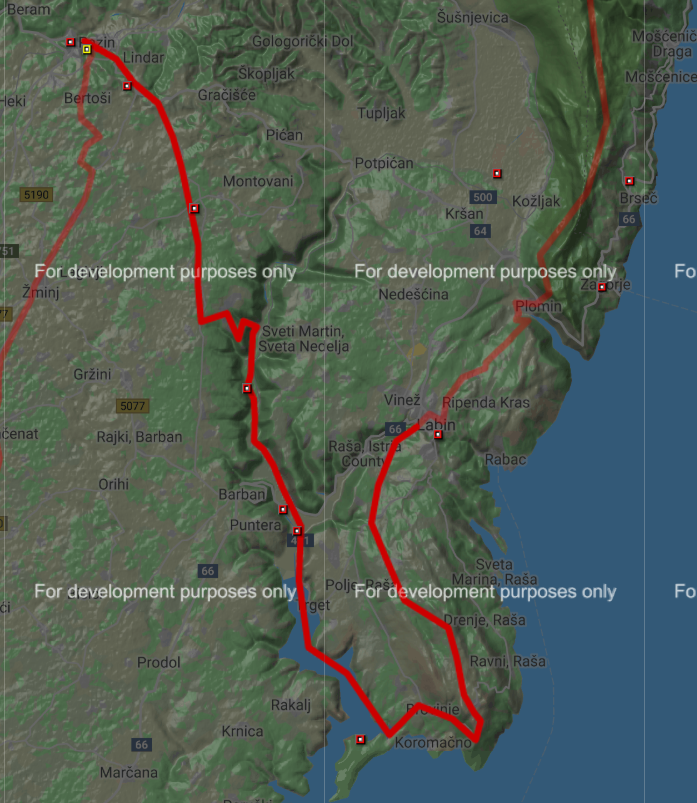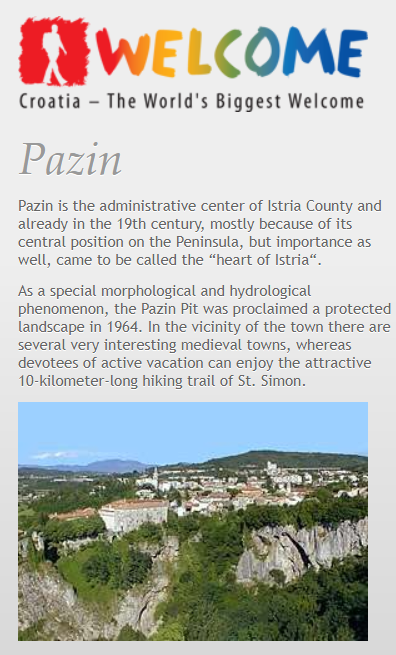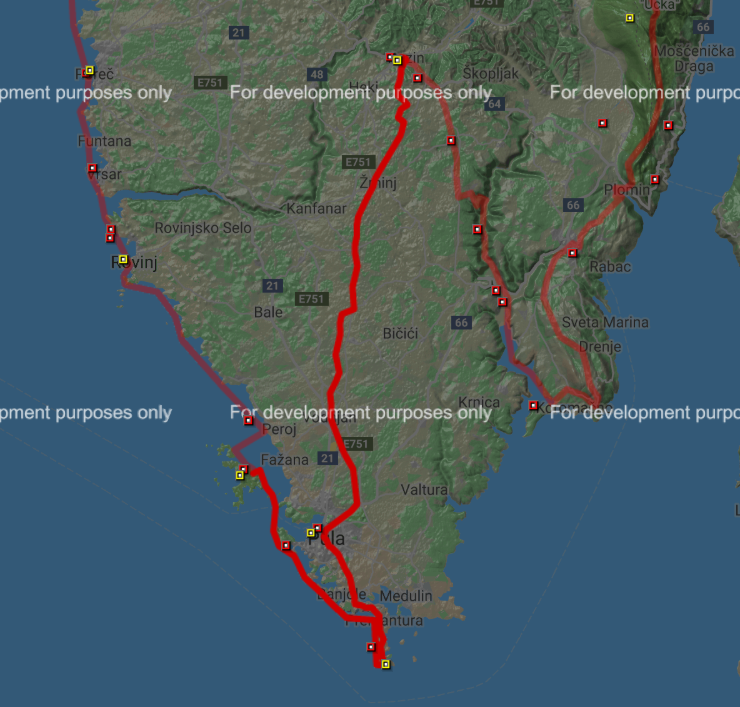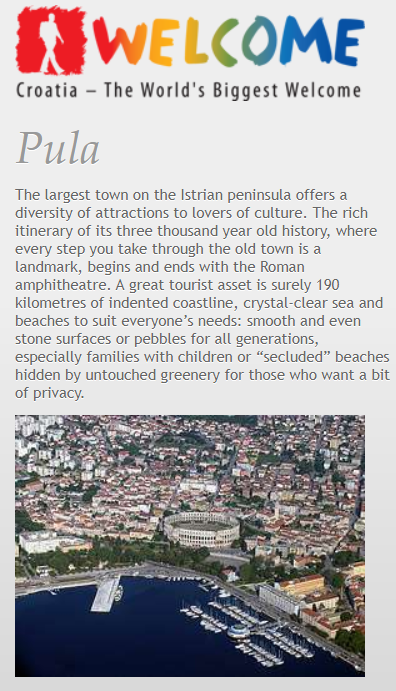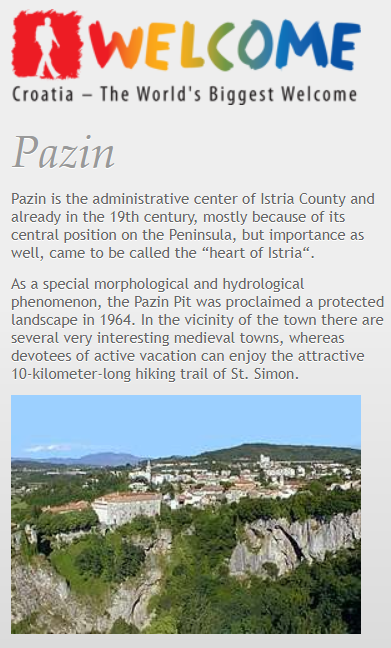8 Magical Towns in Central Istria that Are Absolutely Worth Visiting
May 30, 2022 - Istria is one of the most fascinating regions of Croatia, and while most are more familiar with its magical seaside towns like Pula, Rovinj, Umag, or Poreč, the many medieval towns in Central Istria are just as impressive and definitely worth being explored.
In recent years, Istria has shown its might as a tourist destination, defying the surreal circumstances caused by the coronavirus pandemic by being easily reached by land from other European countries. But Istria is not at all a consolation prize for its proximity, quite the opposite. The largest peninsula in the Adriatic is home to spectacular towns, world-renowned wines and olive oils, unique cuisine, numerous beaches, five-star hotels, and a wealth of culture and history.
But not everyone comes up with an idea of this region beyond the sea, the islands, and the beaches, something that happens similarly in Dalmatia. Some forget that much of Istria's magic lies (not so) far from the coast. With this in mind, here we show you some of the best destinations you can visit in Central Istria. Warning: Not to be confused with Central Istria as a public administration, since it only covers some districts. In this article, we will mention destinations on the Istrian peninsula that are not located by the sea.
Pazin
Located right in the heart of Istria, Pazin is known for medieval Pazin Castle, the former residence of the Istrian margraves. The intensity of life here is pretty much the same in winter and summer, with the monthly exception of every first Tuesday, when a flood of curious buyers from all over Istria runs into the town to visit the traditional Pazin Market. Pazin is very rich in culture and history due to the presence of different civilizations, empires, and governments throughout time. Be sure to visit the Pazin castle, the Pazin abyss, the Franciscan monastery, the Memorial Center of Union and Freedom, the state archives, and more. Learn more about Pazin here.
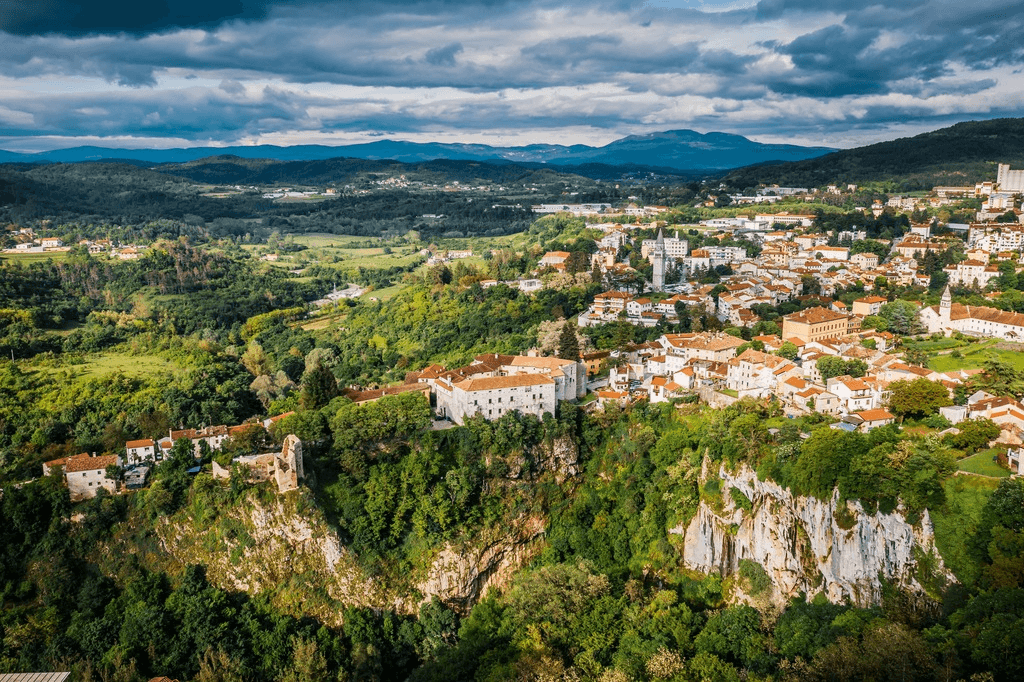
Image: Tourist Board of Central Istria/Official Website
Motovun
Motovun sits on top of a hill towering over the valley of Mirna, the biggest Istrian river. The location was settled since Celtic times, but the town we know today was mostly built under Venetian rule in the Middle Ages. Its centuries-old walls and buildings are the best preserved in Istria, giving the place a unique charm. Yet Motovun is more than its quaint architecture and breathtaking view. It is the Croatian capital of truffles and hosts a famous film festival, which will take place from July 26 to 30 this year. Learn more about Motovun here.
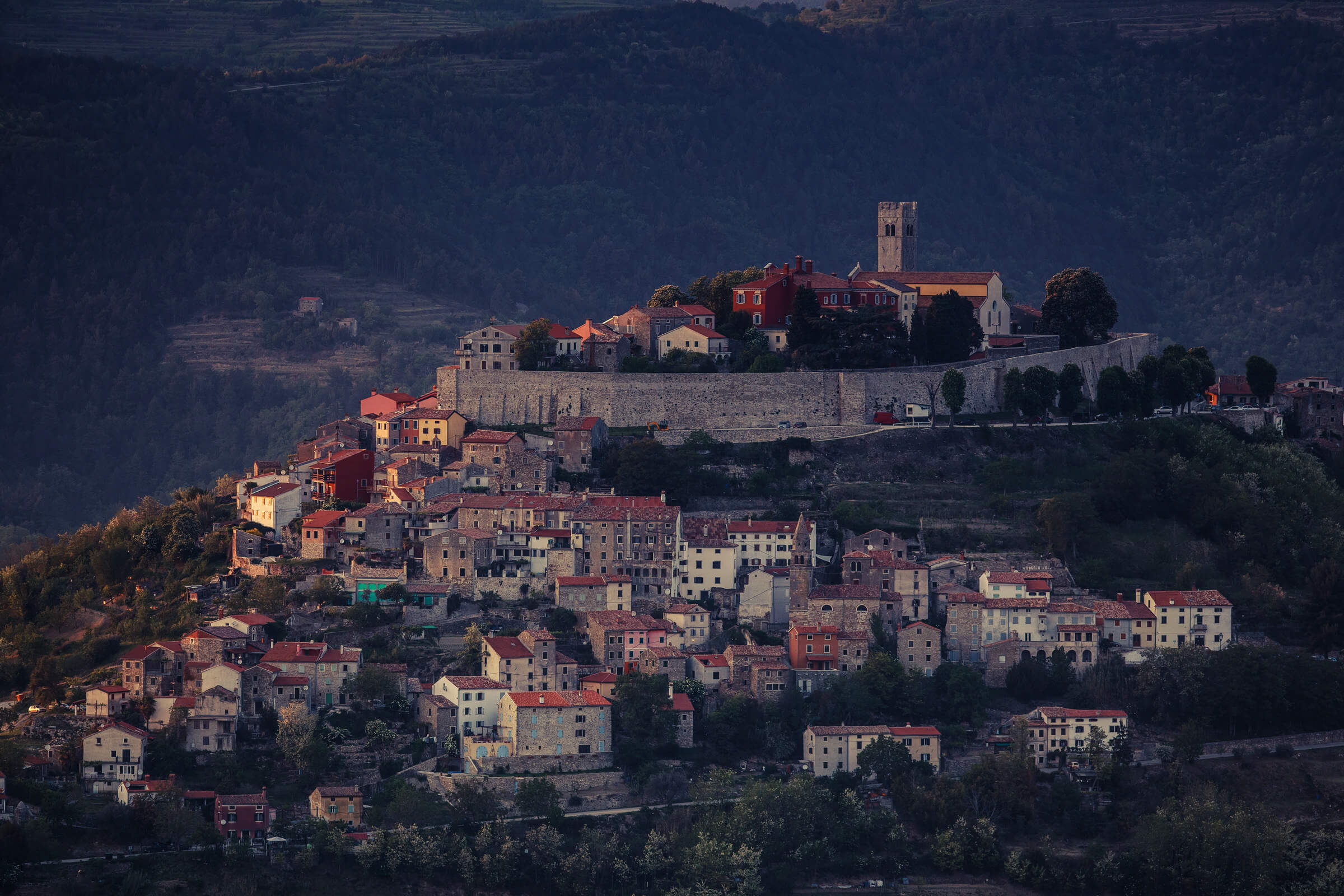
Photo: Mario Romulić
Hum
Often referred to as the smallest town in the world, Hum is a town situated on a hilltop above the source of the Mirna River. It is located in the vicinity of Buzet and Roč. The towns of Roč and Hum have been connected through a shared history and culture since ancient times, and are now also connected by the famous Glagolitic Alley. Hum has just 20 inhabitants, and therefore its well-known name as the smallest town in the world. Learn more from Hum here.
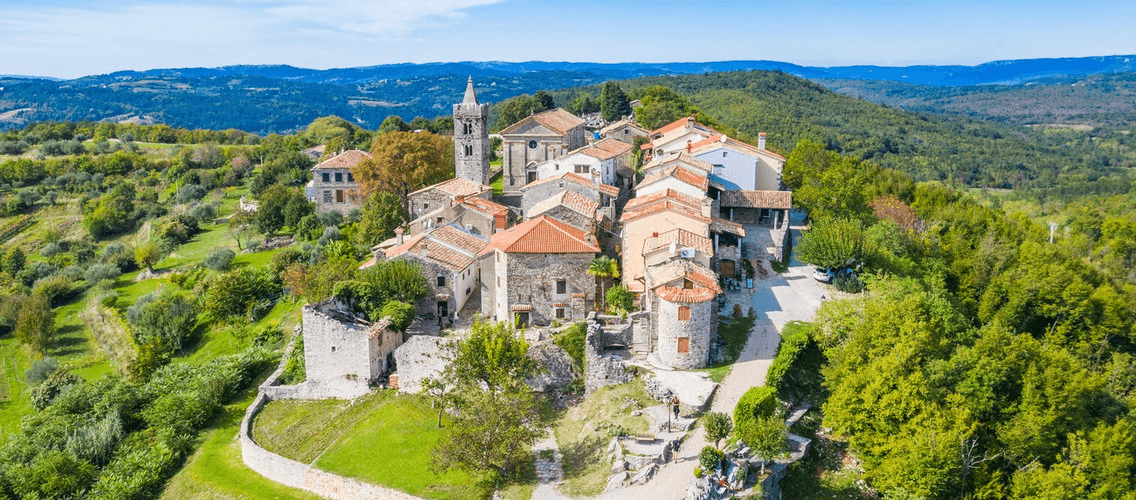
Image: www.valamar-experience.com
Labin
Labin is the biggest town in the otherwise not-so-populated and not-so-popular eastern Istria. In the past, the town was known for its coal mines. Nowadays, all the mines have been closed, and there are no more miners. The community is turning more and more towards tourism - but is far from being overwhelmed by it. Its old town, sitting on top of a hill, is among the most beautiful ones on the peninsula. Although it's not located by the sea, and exactly because of that, Labin has a stunning view of Kvarner bay. Learn more about Labin here.
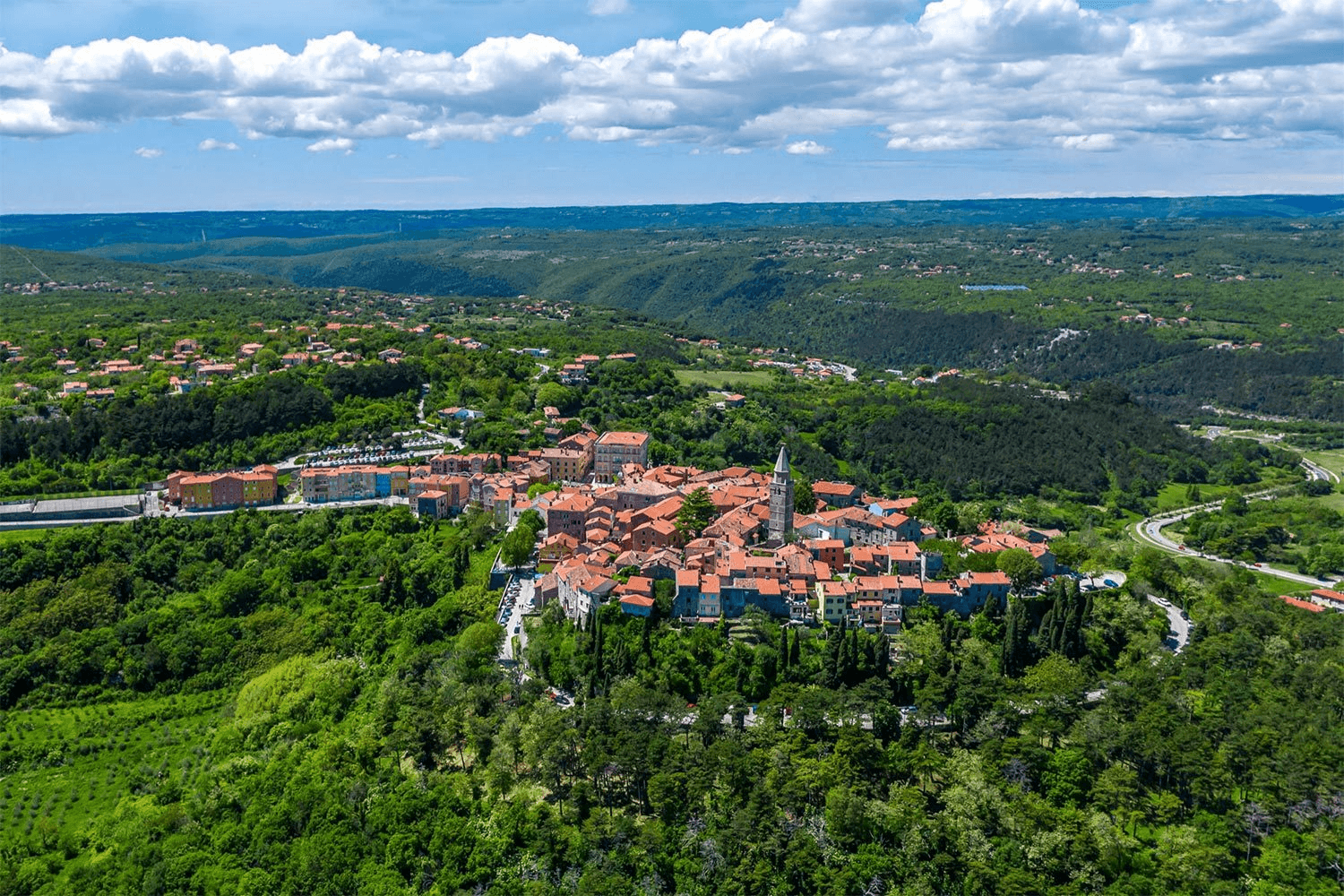
Image: Labin-Rabac Tourist Board/Official website
Vodnjan
Vodnjan is situated near Pula, where excellent olive oil is produced, and its surroundings have the largest number of kažun houses, dry-stone houses in the Mediterranean. The largest church in Istria –Parish Church of St Blase was built at the end of the 18th century, with the 63-meter-high bell tower. The church holds a valuable collection of sacral art and preserved bodies of saints, the so-called Vodnjan mummies, due to which it is visited by around 16000 people a year. Learn more from Vodnjan here.

Image: www.visit-croatia.hr
Buje
The area of the town of Buje is located in the northwestern part of the Istrian peninsula. Approximately 5,300 inhabitants live in an area of 103.40 km2. The town of Buje is located between the rivers Mirna and Dragonja. In the north, there are the hills of the Upper Buje, and in the south the Adriatic Sea in Kanegra and the Piran Bay. It is a rolling and hilly area covered with vineyards, olive groves, and arable land dotted with oak, cherry, and pine forests, a karst belt full of interesting geological phenomena, and meadows of Mediterranean vegetation, among which thyme and spruce predominate. Learn more about Buje here.
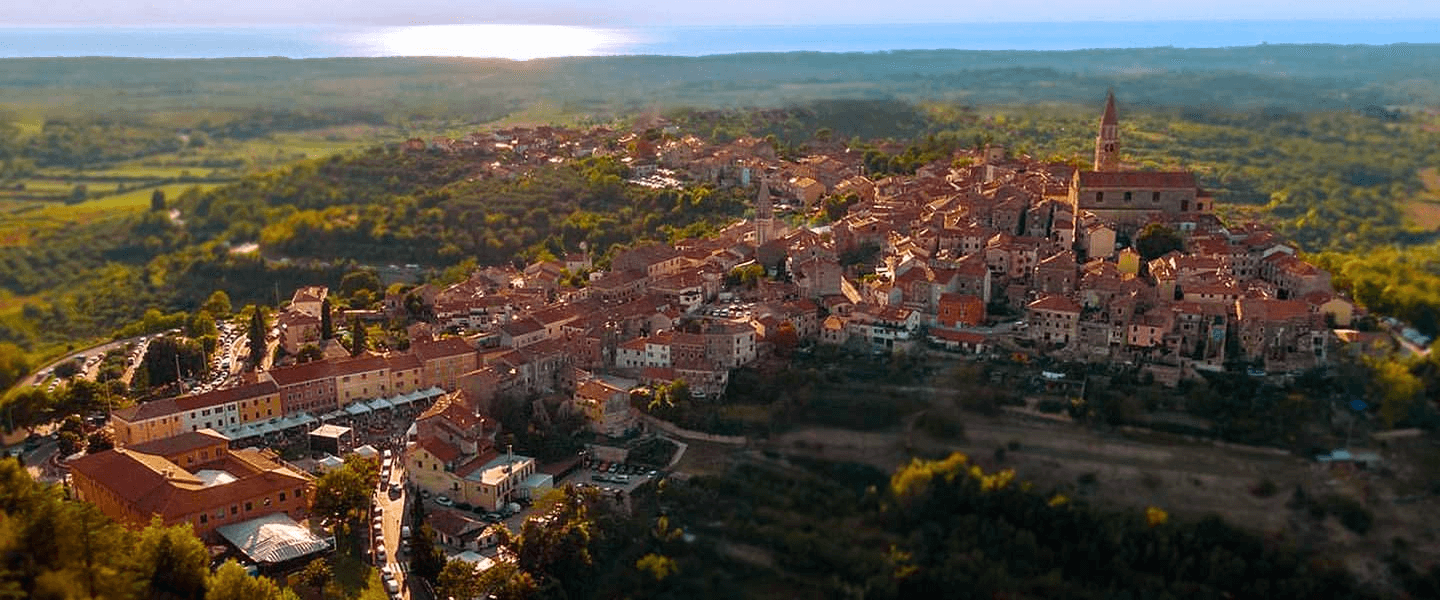
Grožnjan
The nearby Motovun might be the quintessential Istrian hilltop town, but Grožnjan is also well worth visiting. As is the case with many Istrian towns, it was settled during the Roman times, built under Venetian rule in Middle Ages, and well preserved up to today. The place was almost deserted after World War II, but in 1965 a group of artists decided to turn the town into an art colony, which remains up to the present. It’s a great accommodation spot for those who don’t need the sea, and it makes for a good base for exploring the hilly part of Istria. Learn more about Grožnjan here.
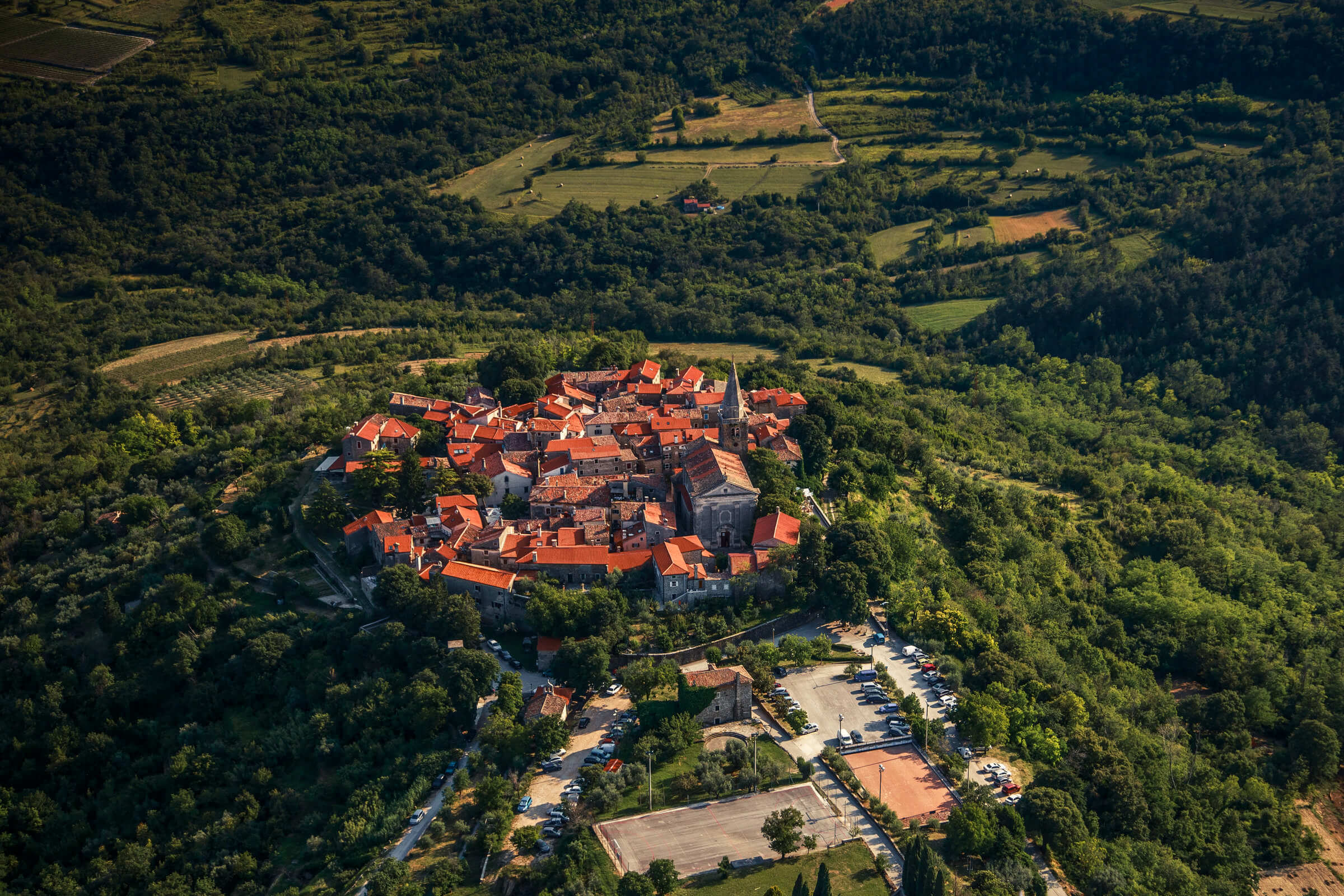
Photo: Mario Romulić
Pićan
Sometimes it is not easy to follow the traces of Pićan in historical sources because it hides under various names. The origin of the name Petina is attributed by some to the assumption that the Diocese of Pićan was the fifth in the world, with the word five (pet, in Croatian) having Celtic roots. Pićan is certainly inhabited in distant prehistory. The oldest parts of the Istrian hillfort were located on the hill of Calvary, north of today's settlement, and then it is assumed that the Celtic tribe Secusa lived there. In Roman times, probably in the same strategically well-chosen place, there was a military stronghold and the settlement of Petina. Learn more about Pićan here.
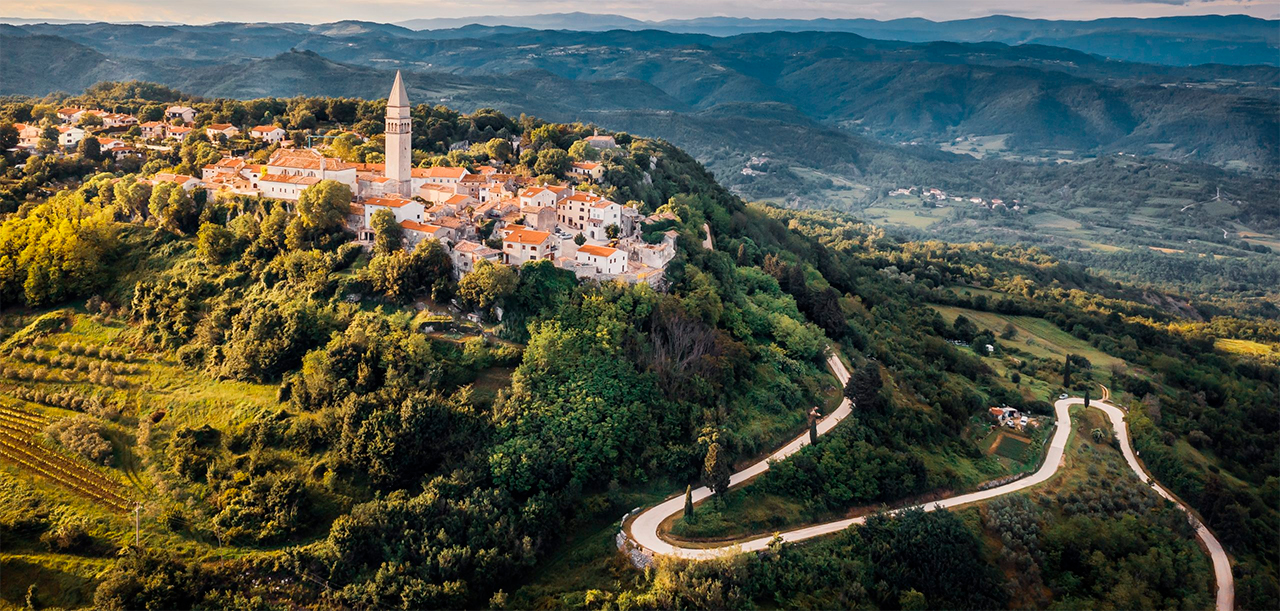
Image: Pićan municipality/Official website
For more on travel in Croatia, follow TCN's dedicated page.
5 Ways to Explore Istria Off the Beaten Path
March 12th, 2022 - There’s so much more to Istria beyond the famous Rovinj landscape or the olive oil and truffle fame. The region is full of treasures to discover, and we're happy to help you plan your visit with five unique ideas for things to do in Istria
And then go ahead and have those truffles anyway - we’d never think to suggest otherwise.
Walk the Parenzana trail
Not necessarily the whole thing, of course: running through three countries, the Parenzana trail is 123 kilometres long in total, and it's perfectly fine to only walk or cycle a part of it. Historically, Parenzana was known as the narrow-gauge railway which connected the Italian port city of Trieste with Poreč in Istria, passing through many inland villages and smaller towns along the way.
Fun fact: as the inauguration of the Parenzana line in Trieste was delayed several times due to various issues, the locals got skeptical after a while. When the first train ceremonially arrived in Trieste on April 1st, 1902, almost no one showed up at the railway station because people were convinced the announcement was an April Fools’ joke.
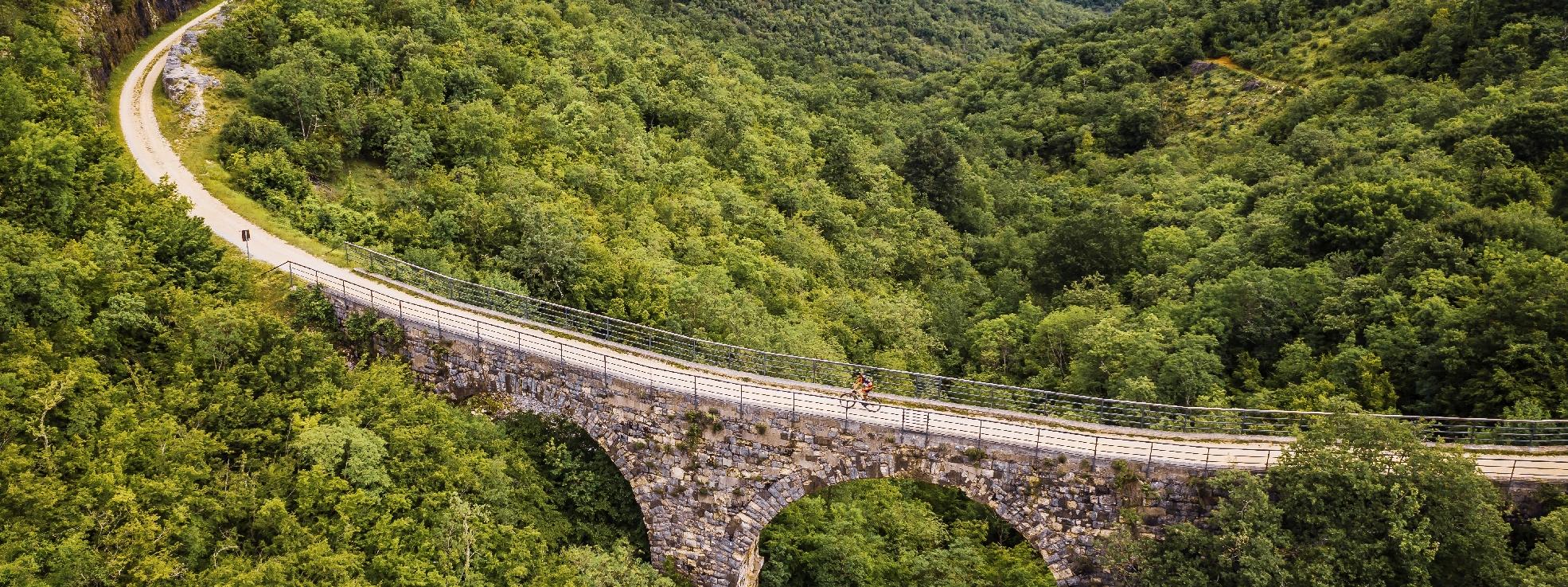 Parenzana trail / parenzana.net
Parenzana trail / parenzana.net
But it wasn’t, and the railway soon made it possible for agricultural produce to be distributed all over the region, stimulating Istria’s economic progress and becoming somewhat of a lifeline for the local population. Although the railway line ceased operation in 1935, it certainly left a mark on the region, and so it was decided to revive the route as a hiking and cycling trail.
Parenzana will take you over bridges and viaducts, now secured by guard rails; it runs through well-lit tunnels and snakes through the lush landscape. The entire trail is well-marked and is split into shorter routes - a comprehensive guide is available on parenzana.net, in several languages.
Ride the zipline over the Pazin abyss
Although Pula is the biggest town in Istria, the county’s administrative seat is actually Pazin, a town located in the very centre of the region.
Pazin boasts a medieval castle that was once a residence of Istrian margraves and hasn’t lost any of its grandeur with time. Perched on top of a tall cliff plummeting into the Pazin abyss, the castle dominates the majestic landscape which inspired literary giants of the likes of Dante Alighieri and Jules Verne.
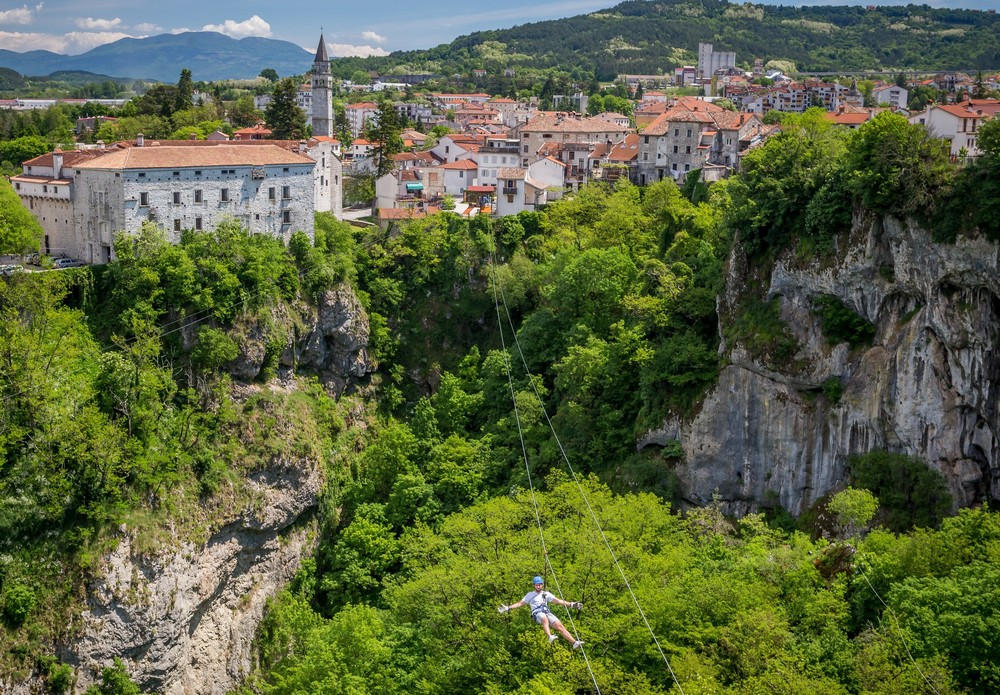 Pazin / Central Istria Tourist Board, photo by Julien Duval
Pazin / Central Istria Tourist Board, photo by Julien Duval
And what better way to take in the impressive sights than flying over the natural attraction? The Pazin zipline runs over the abyss in two stages: the first cable is 220m long and the second 280m, giving adrenaline lovers plenty of time to admire the historic landscape, as well as the karst phenomenon down below.
The zipline operates regularly from May 1st, but can be visited in the off-season as well upon request, provided you’re visiting with a group - contact info is available on their Facebook page.
Hike the contraband trails of Učka mountain
Have you ever had a chance to retrace the steps of smugglers of the past? A few years ago, three unique hiking trails were established on the Učka mountain, the natural border between Kvarner and Istria, introducing hikers to the history of contraband activity in the area.
 Učka mountain © Mario Romulić
Učka mountain © Mario Romulić
In the 1930s, a duty-free zone was established on the coastline around Rijeka to stimulate tourism and the local economy. Overnight, consumer goods became much cheaper, and the struggling population soon started to smuggle products such as sugar and petroleum out of the duty-free zone and over the Učka mountain on foot. They sold the goods for profit in the rest of the region as a way to survive in times of scarcity - check out this TCN feature for the full story.
You can find detailed information about the hiking routes in a dedicated mobile app, along with a list of accommodation providers and restaurants in the area. It’s available to download on GooglePlay and AppStore - search for 'Kontraband thematic trails'.
Discover the history of mining in Raša
Istria has a long history of coal mining, specifically in the area around Labin town located off the eastern coast of the peninsula. Arguably the most unique place in the mining landscape is Raša, known as Istria's youngest town which was purposefully built in the 1930s to house miners and their families.
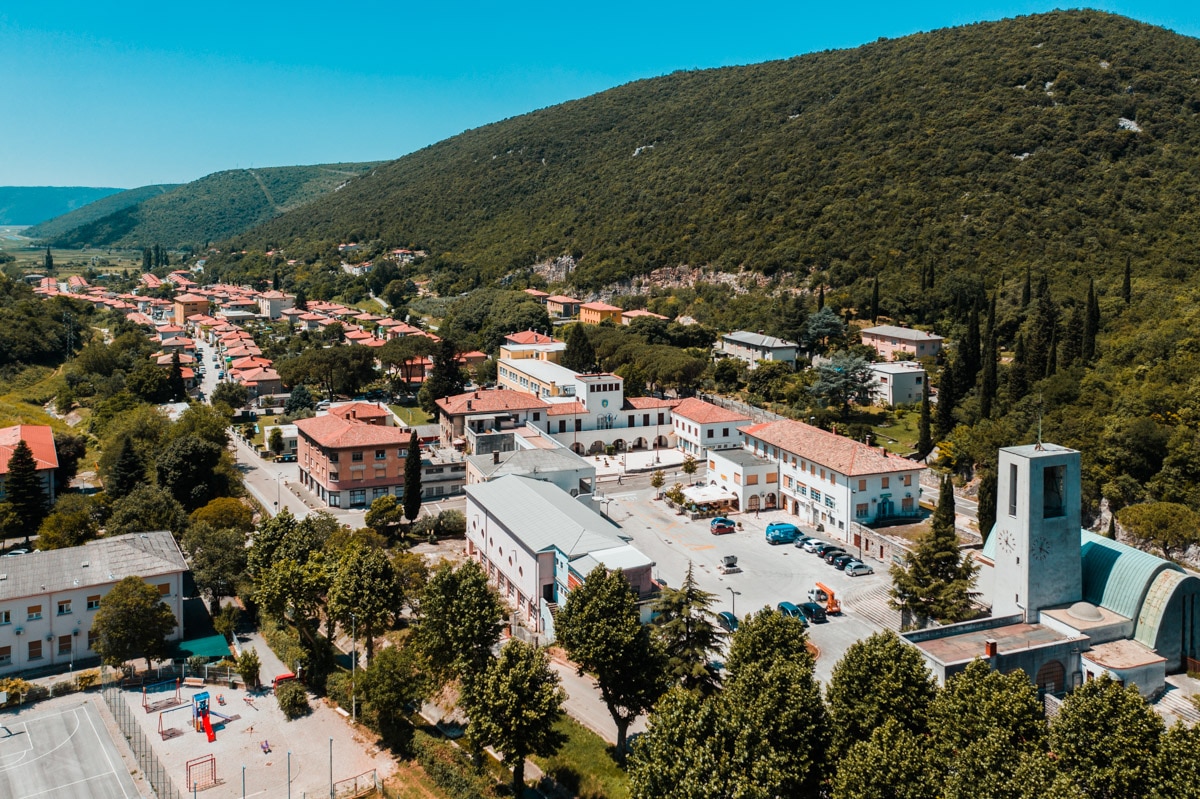 Raša town / Raša Tourist Board
Raša town / Raša Tourist Board
Two pairs of streets lined with former miners’ houses meet at the central square in Raša, crowned with a church built in the shape of an overturned mining cart and dedicated to the patron saint of miners, St Barbara.
Even though the mines closed a long time ago, you can experience what it was like to spend your days in the dark underworld. Located on the main square in Raša, the Miners House Arsia tells the story of Istrian miners and provides insight into their lives both above and below ground.
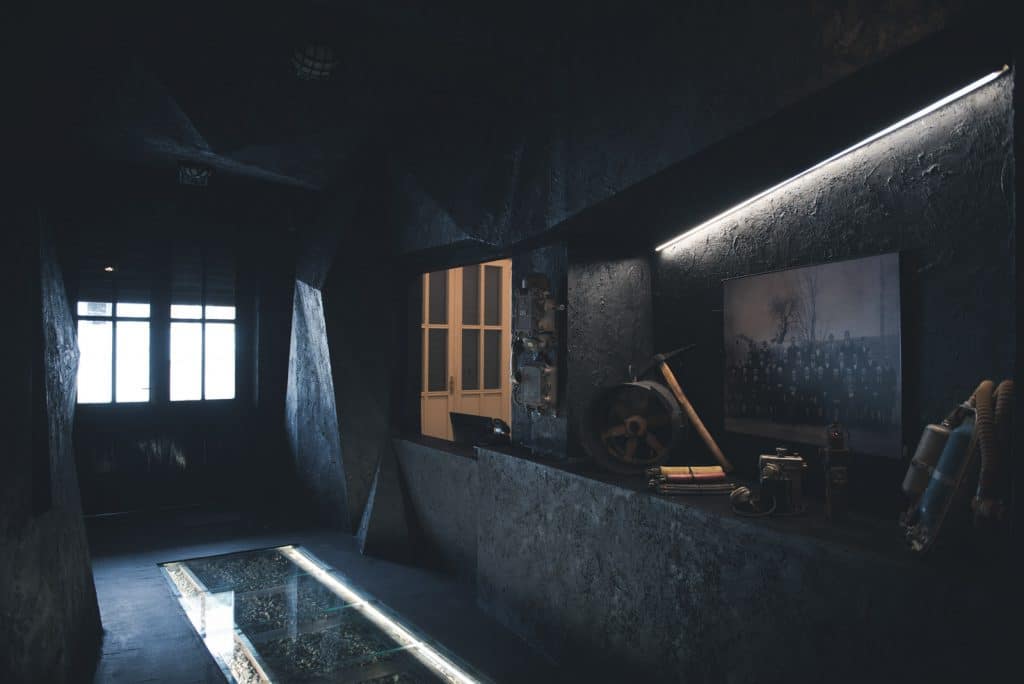 Miners' House Arsia / Raša Tourist Board
Miners' House Arsia / Raša Tourist Board
Starting from the entrance built like a mining shaft, the museum evokes the atmosphere of a mine - you can walk on the original railroad tracks surrounded by the sounds of coal digging and distant explosions, watch archival films to learn the stories of real miners who once inhabited the town, but also step into their homes thanks to a perfect recreation of a typical miner’s apartment.
Learn more about the Miners’ House over at the Raša Tourist Board.
Visit Croatia’s oldest lighthouse in Savudrija
The Adriatic coast is dotted with numerous historic lighthouses, most of them built in the 19th century. The one in Savudrija, the northwestern tip of Istria, boasts two champion titles: it’s the oldest active lighthouse in Croatia, and the world’s first lighthouse powered by coal gas.
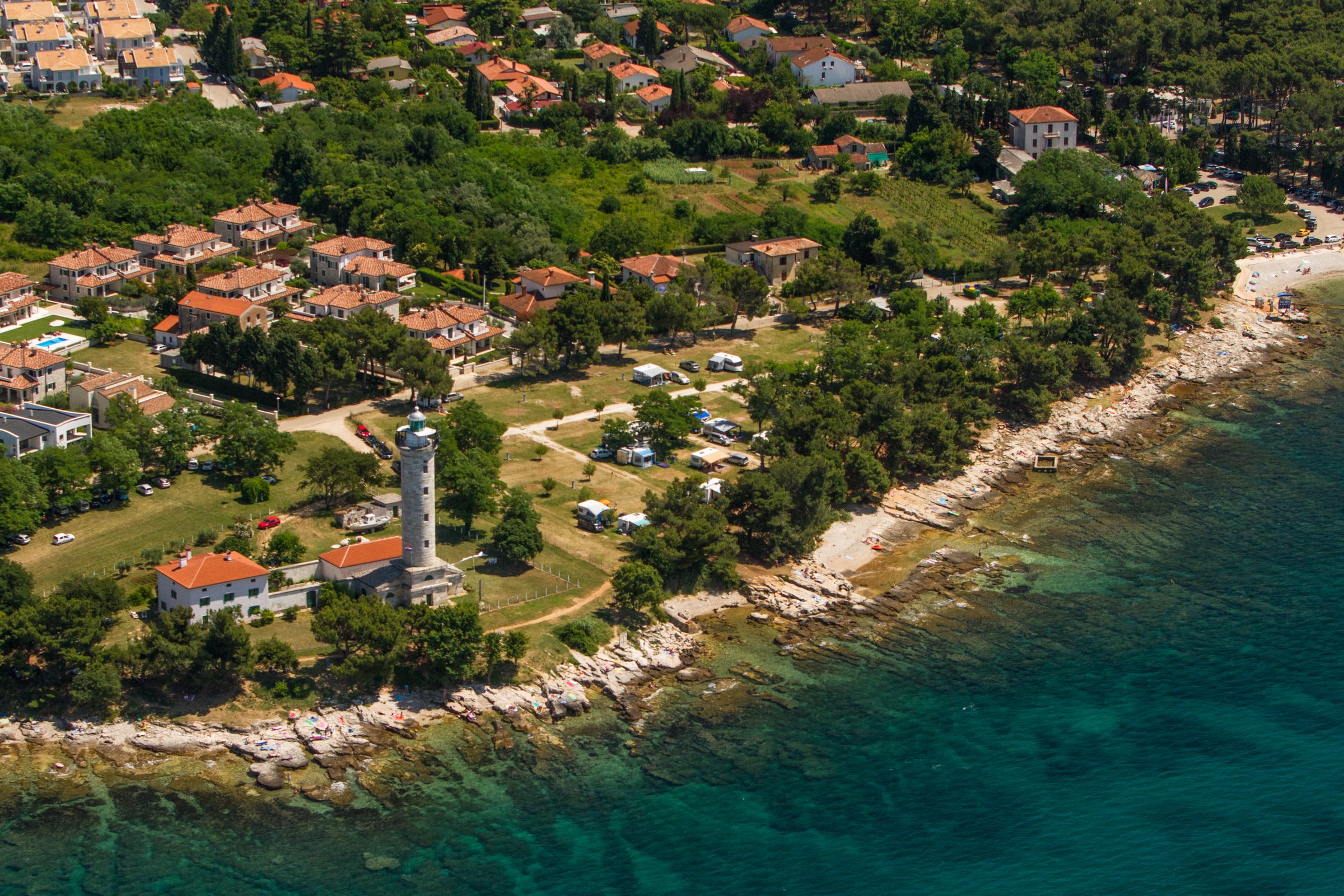 Savudrija lighthouse © Mario Romulić
Savudrija lighthouse © Mario Romulić
The lighthouse was built of white Istrian stone and powered by coal shipped in from the Labin mines. It was inaugurated in 1818 and became a local sensation overnight: people were so fascinated by the new structure, the lighthouse keepers were soon granted a licence to bear arms and were instructed to shoot any enthusiasts who attempted to scale the building and climb to the top.
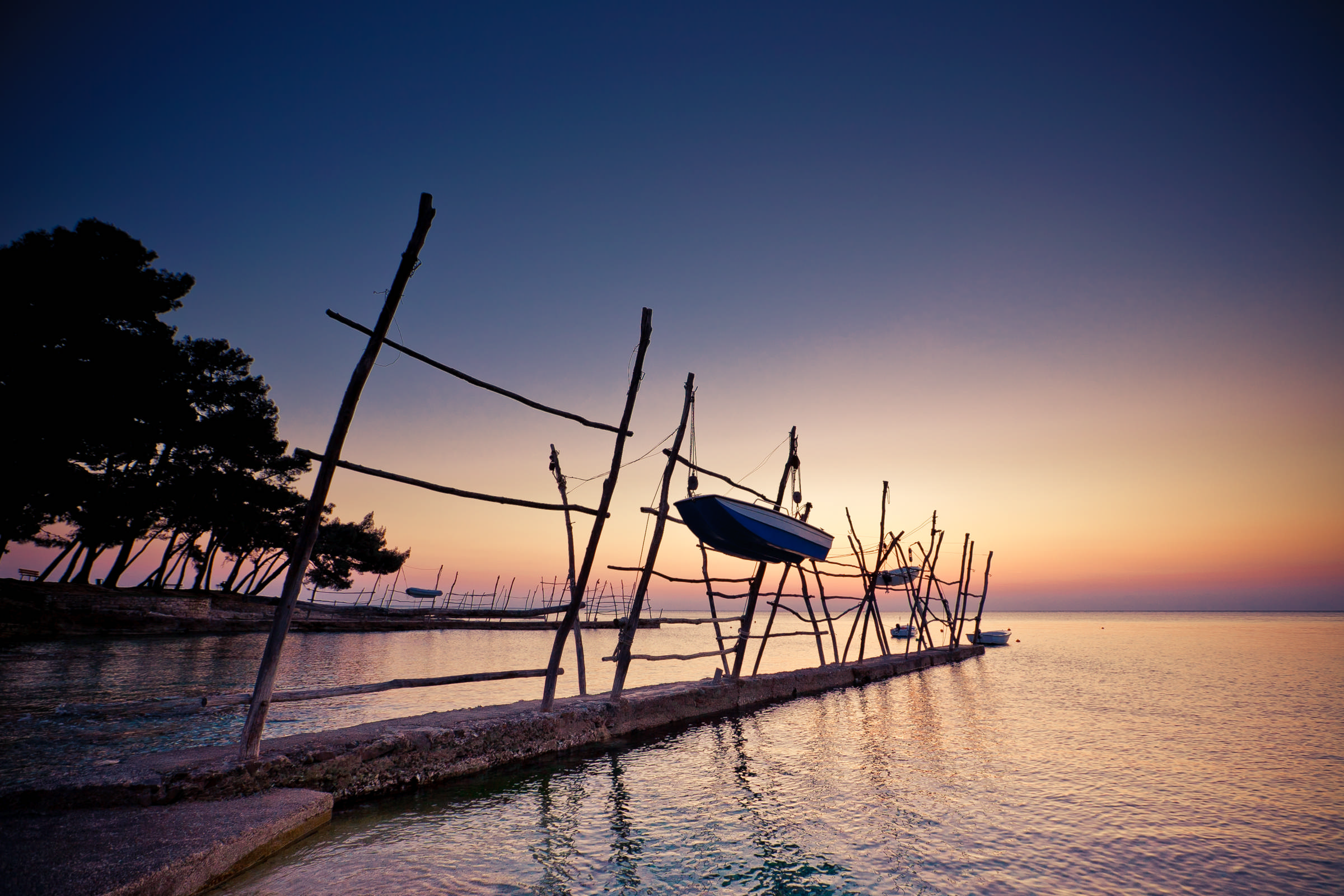 Savudrija © Mario Romulić
Savudrija © Mario Romulić
Nowadays fully automated and monitored by a single keeper, the lighthouse isn’t that much of a novelty anymore, but is still a beautiful landmark and in itself a good enough reason to visit Savudrija. Let it also be known that the place boasts a pretty spectacular coastline, lined with pines and traditional fishermen's boats. The waters around Cape Savudrija are favoured by surfers and divers alike.
New Campaign: Digital Nomads in Pazin Desired to Extend Season
January 31, 2022 - The Central Istria Tourist Board director has revealed that digital nomads in Pazin are the best way to extend the season, with many renters showing interest in advertising their accommodations.
Villas with swimming pools or holiday homes in central Istria have been a hit for years now. However, Croatia's largest peninsula wants to bring their popular accommodations closer to digital nomads, reports Jutarnji List.
Following the example of larger Croatian cities, the Central Istria Tourist Board recently launched the campaign "Live and work in Central Istria," which wants to attract digital nomads to Pazin and its surroundings this year. According to the Tourist Board director, Sanja Kantaruti, about 30 renters have already shown interest in hosting digital nomads who would extend their season. But why should digital nomads come to Pazin and its surroundings outside of summer?
"Facilities in central Istria operate throughout the year - from restaurants to museums and other facilities. We are constantly looking for ways to extend the season and become a year-round destination. Very often people who come on holiday to Istria also work. On the other hand, central Istria is different from the already established destinations of digital nomads, such as Zagreb, Split, and Dubrovnik," Kantaruti believes.
He adds that they could be attractive because they are not larger and busier environments. That is why they recently held a conference for all tourism workers and especially explained to renters what digital nomads are looking for - above all, a comfortable place to work.
"Every day, new landlords contact us who would like to join the project. The only problem so far is that the prices of our villas and holiday homes are quite high even out of season, and yet this is a long-term lease. We are also cooperating with our development agency Srce Istre in Pazin. They equipped the co-working space and organized gatherings. And that attracts digital nomads."
Therefore, Kantaruti expects significant interest, as was the good interest of visitors to several gastronomic events out of season.
Namely, in the winter months, from November 1 to March 1, the number of overnight stays in central Istria increased! In 2016 and 2017, there were 4502 overnight stays and 6180 in 2019. However, they believe that various events can achieve more than that.
"This winter, we had the 'We love winter while there is a hood' event, now in February, the Days of Honey delicacies begin. On the weekends, restaurants and taverns are full, and even the caterers told me that they had to turn people away because there is simply no space," says the Tourist Board director.
The Central Istria Tourist Board was the first to function on the principle of an association. These associations of smaller and unprofitable tourist boards have been discussed in Croatia for years to be efficient and reduce costs. But now, most of them are deciding on a project association, which would be the first step towards the formal tourist board. The Central Istria Tourist Board includes Pazin and eight surrounding municipalities - Cerovlje, Gračišće, Karojba, Lupoglav, Pićan, Tinjan, Sveti Petar u Šumi, and Sveti Lovreč. Although it seemed complicated at first due to different political options in other municipalities, it proved to be successful.
Thus, last year, they expanded their cooperation and teamed up with nearby Buzet, Barban, Žminj, Kanfanar, and Svetvinčenat. They worked together to promote enogastronomy and came out with a new promotional video, "Authentic Istria - Good mood / Good food," directed and produced by the Labin company Level 52. It will first be promoted on the domestic market, the second most important after Germany.
"We were founded in 2007, and in 2020 we joined the project. There are 14 municipalities and cities in it. We are the coordinator of all activities, and we have invited other tourist boards, those from the surrounding area, to join us because we have the same product. Tourists are not interested in the boundaries of the municipality. So this is the question for mayors and mayors. Some have already shown interest, but that remains to be seen. This year, all of us in the tourist boards are expecting changes," Kantaruti points out.
However, central Istria will inevitably see good results this year. The first significant wave of tourists is expected for Easter.
For more news and features about digital nomads in Croatia, follow the dedicated TCN section.
Croatian Panissimo Project Offers Fresh Bread from Vending Machines!
April the 9th, 2021 - The Croatian Panissimo project is an unusual and innovative one. Would you fancy getting your hands on your daily fresh bread and other similar items from a vending machine when the bakeries are shut?
As Poslovni Dnevnik/Marta Duic writes, having fresh, quality and home-made bakery products at your fingertips and available 24 hours a day is the basic idea behind the innovative Croatian Panissimo project whicb involves setting up ''bread stations'' in the form of vending machines. They were initially set up last month in Pazin, Istria.
The Croatian Panissimo project is a business idea from a company named Reginex, an Istrian manufacturer and distributor of bakery products, which will offer its products through vending machines throughout the Istrian peninsula.
As Paolo Rados, the manager of the Croatian Panissimo project, pointed out, in their bread stations, or rather their bread vending machines, there are only daily fresh bakery products, the devices are filled up with them in the morning, and then they're replenished once again in the afternoon. All of the bread that is not sold that day is replaced with fresh items.
"We came up with the idea with the desire to simplify and speed up the experience of buying fresh bread, which is more or less an everyday food, and to ensure the availability of daily fresh homemade bread and bakery products throughout Istria. The reactions from the market have been excellent, our customers have accepted this way of buying bakery products because they have realised that it's faster, closer and always fresh for them,'' explained Rados.
The Pazin-based company Reginex has otherwise been engaged in baking since way back in 1990 and can boast that they're the only producer in all of Istria that produces their own natural yeasts and that uses the process of delayed fermentation in the production. They sell their products throughout Istria through their own retail stores, supermarket chains and local stores, as well as through their new Panissimo bread stations.
In addition, Reginex is a representative of several leading global manufacturers of bakery and confectionery equipment, and offers its equipment, engineering and service throughout Croatia and the wider region. It currently has 55 permanent employees, and that number increases by 10 to 15 additional seasonal workers during the summer months.
"There are six types of bread in the vending machines, croissants, donuts and strudels, and the best-selling products are our homemade bread, bobuli and croissants. We're definitely planning to expand and in the short term we plan to install bread machines in the areas of Pula, Porec, Rovinj and in the surrounding locations.
With our bread stations, we want to offer bread which is always available for the inhabitants of scattered villages and municipalities in the interior of Istria, where some of them do not even have a local store and have to travel to a neighbouring area to purchase even the most basic of groceries,'' stated Rados.
Although vending machines are known for offering coffee and other beverages, snacks and milk, the Croatian Panissimo project is the first such device specialising in fresh baked products. Since they've been engaged in engineering and equipment in the bakery for many years now and are representatives of a number of world-famous brands of bakery equipment, Reginex decided to modify those original snack vending machines.
Since the space inside the bread machine is limited in size, for now they have decided to offer their best-selling products whose prices range from five to ten kuna, and Rados announced that the vending machines will be filled according to customer interest after a while, when such trends and habits can be monitored.
"The first Panissimo stations are in Novo Naselje in Pazin and at the Pazin bus station, and they will soon move on, to Porec, Rovinj, Pula and smaller places within the Istrian interior," said Paolo Rados.
For more, follow our business section.
People Also Ask Google: How to Get to Istria, Croatia in 2021?
February 17, 2021 – In Google's "People also ask" feature, the hard questions are the ones that start with "how." It is not always easy to find answers how to do something or how to get somewhere. However, in this article, we will try to explain how to get to Istria, the biggest and famous Croatian peninsula.
Located in the most western part of Croatia, Istria is a peninsula known for its rich cultural heritage, as well as it's delicious gastro offer that includes world's best wine, olive oil, and truffles. Last year, Istria was named world's best olive oil region for the sixth consecutive year, which is one more reason why Istria is an unavoidable place to visit when in Croatia.

Sources: Istria.hr, Pexels, Romulić and Stojčić
We will let you explore the charms of Istria for yourself, but first, we will try to help you how to get to Istria.
How to get to Istria Croatia by car?
Istria is one of the best, if not the best traffic-connected Croatian coastal region. Thanks to its geographical position, it achieves a record number of tourist arrivals and overnight stays every year, and the cities of Poreč and Rovinj are at the very top of Croatian tourist destinations.
The largest number of tourists come to Istria by land, by personal vehicles, from the close countries of Germany, Austria, and Italy. If you're coming to Istria from those countries, or from that direction, you must pass through Slovenia.
There are four main border crossings with Croatia and Slovenia in Istria. The first ones are Plovanija and Dragonja/Kaštel, from the direction of Koper, marked in red on the photo below.

Screenshot Google Maps
The road to Plovanija goes along the Slovenian shore, and the border crossing Dragonja/Kaštel is on the road E751. After the Croatian border, that road connects with the most famous and most important road in Istria – the so-called Istrian Y, a Y-shaped highway, which connects all parts of Istria.
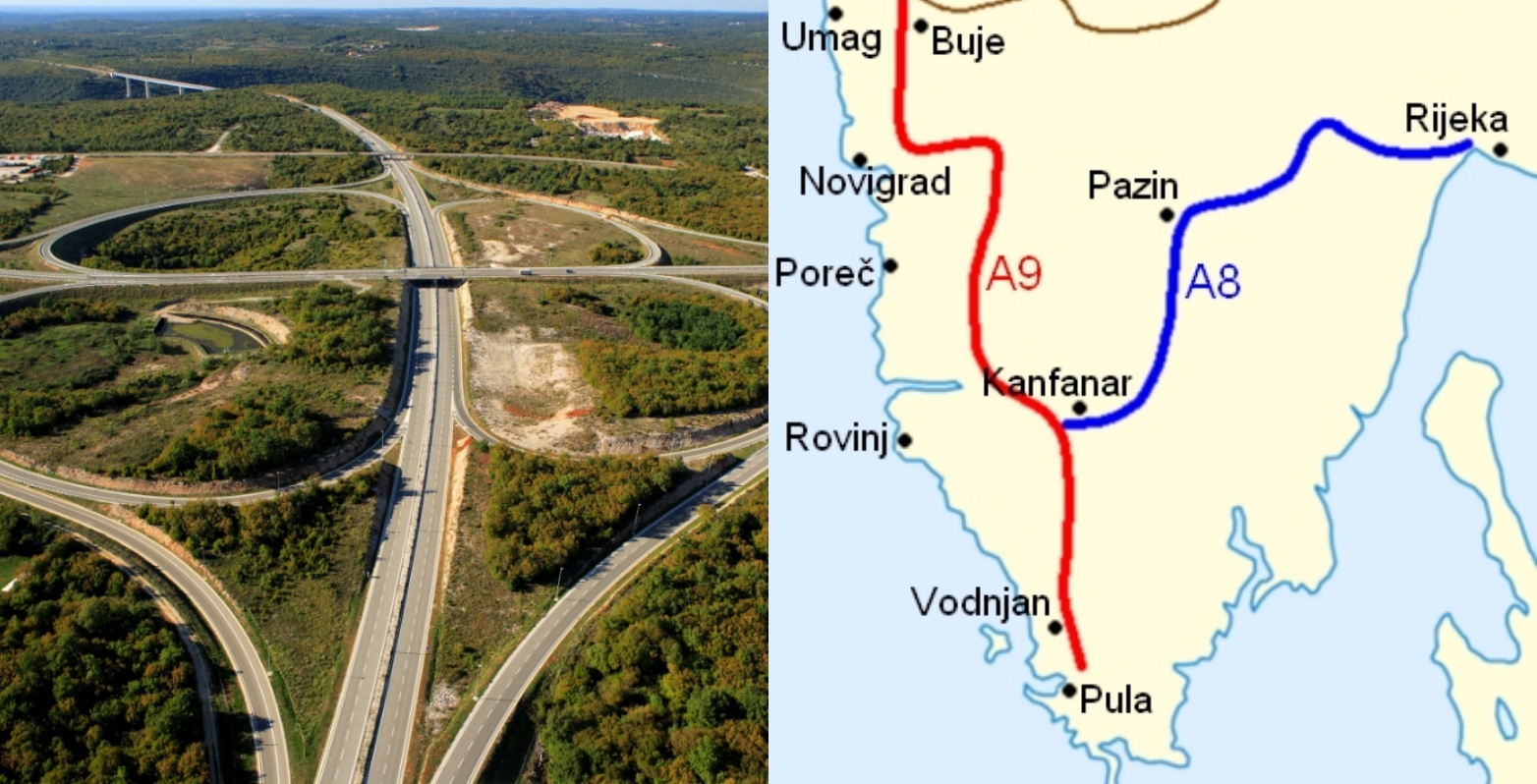
On the left: Center of Istrian Y in Kanfanar (Romulić and Stojčić) / On the right: the map of Istrian Y (Wikipedia)
That part of the Istrian Y, marked in red on the photo below, goes along the western shore, and it is a highway A9 from the Slovenian border to Pula. It connects Istrian cities of Umag, Novigrad, Poreč, Rovinj, and Pula. However, the highway itself is a little away from these cities, so you will have to turn to state roads to reach them.
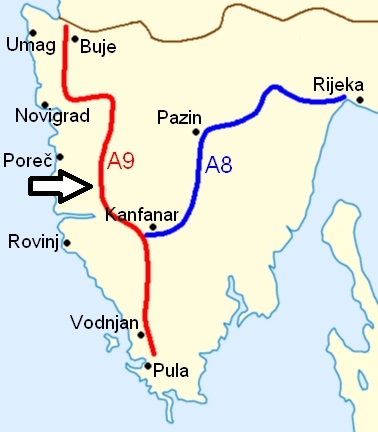
A9 highway, a part of Istrian Y, marked in red / Wikipedia
The second two important - and also the busiest - border crossings in Istria are Pasjak and Rupa, marked in blue on the first photo. Although they are located in the Primorje-Gorski Kotar County, they are a gate to Istria County.
As shown on the photo below, the highway E61 goes to Croatia via the Pasjak crossing border from the direction of Trieste in Italy. If coming from the direction of Ljubljana, you must cross the Rupa crossing border. Highway E61 (in Croatian: highway A7) from both Pasjak and Rupa end in Matulji (marked in red) near Rijeka, where it connects with the second part of Istrian Y – highway A8 that goes to Kanfanar, the center point of Istrian Y.
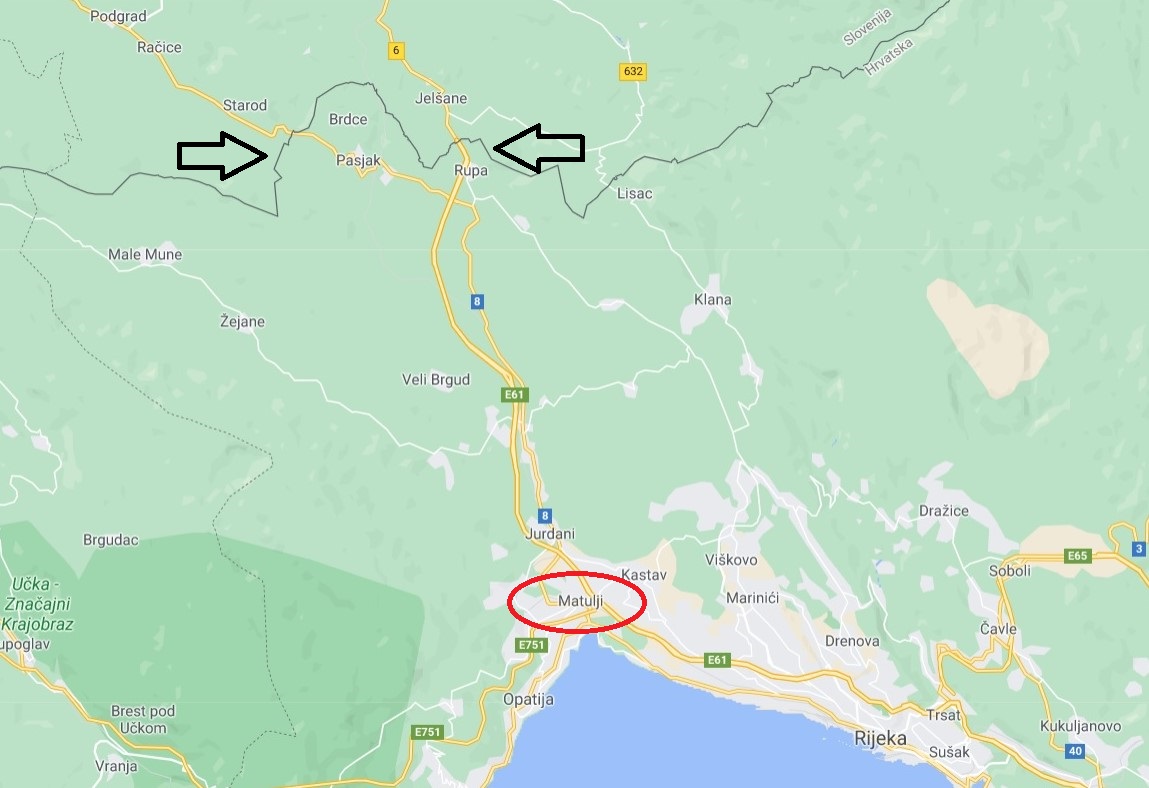
Screenshot Google Maps
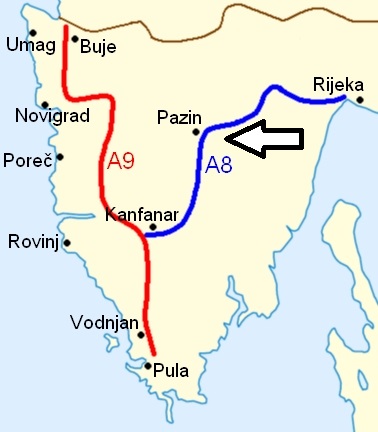
A8 highway, a another part of Istrian Y, marked in blue / Wikipedia
Remember, once you reach Istrian Y, you can reach any part of Istria. Istrian Y is actually a system of two highways, A8 and A9 – learn more about the Istrian Y.
Other Slovenian-Croatian border crossings are Bregana near Zagreb and Macelj near Krapina, from where you can go to Istria via highways E59 and E65.
How to get to Istria by plane?
The only airport in Istria is the one in Pula, while the other close airports are in Friuli Venezia Giulia Airport in Trieste, Marco Polo Airport in Venice, and Treviso Airport in Italy, Jože Pučnik Airport in Ljubljana in Slovenia (also known as Brnik Airport or Fraport Slovenia), Zagreb Franjo Tuđman Airport and Rijeka Airport in Croatia.
Pula Airport welcomes both charter and scheduled flights. Before many flights were canceled due the pandemic, Pula Airport had a solid tourist traffic. One of the most popular airline in Pula was Ryanair, offering cheap flights to some of the biggest European cities. However, the traffic in Pula Airport dropped by 89.6 percent in 2020, compared to the record 2019.
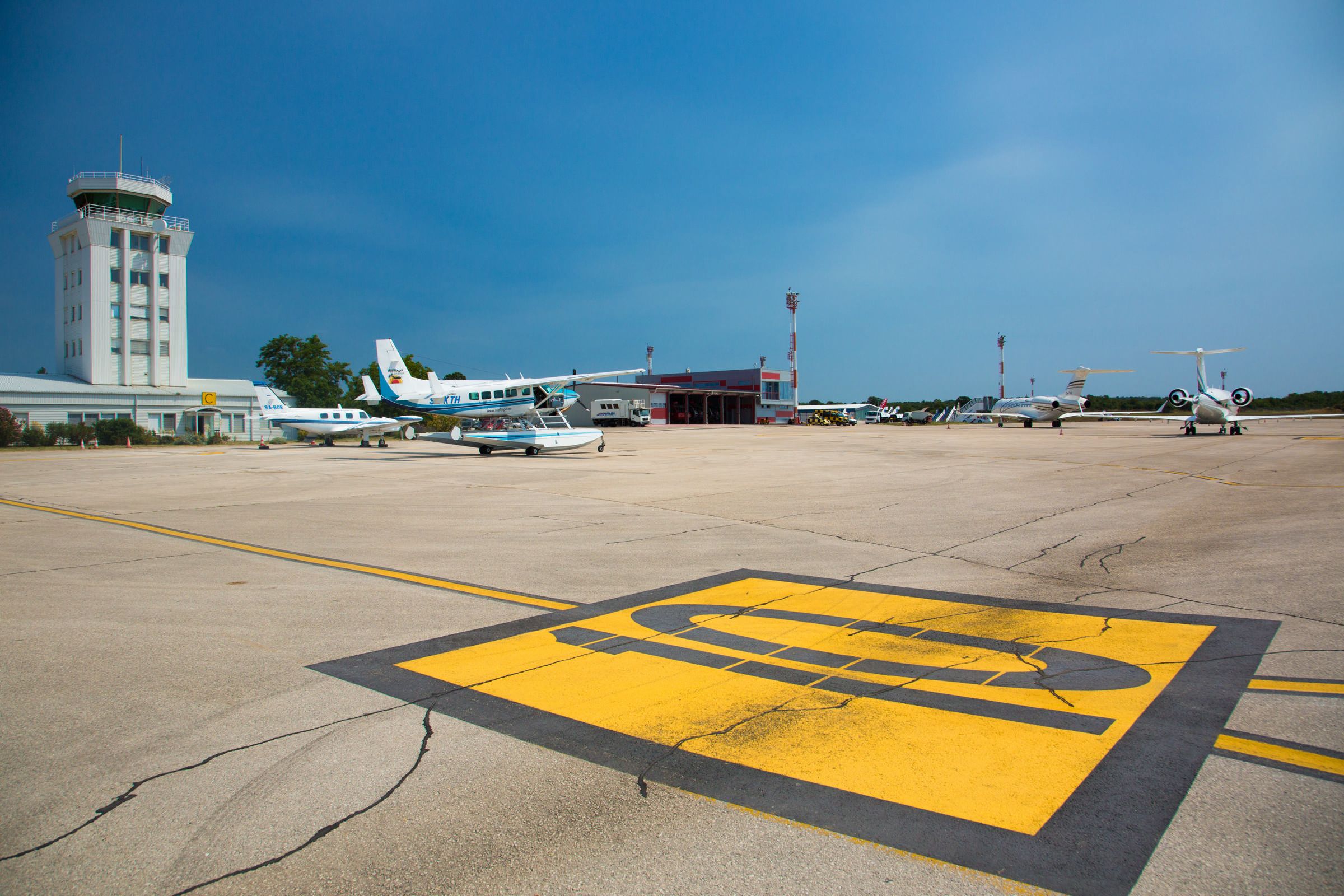
Pula Airport by Romulić and Stojčić
Airlines operating to Pula Airport in 2021 are Air Serbia, British Airways, Croatia Airlines, EasyJet, Eurowings, Finnair, Jet2.com, Lufthansa, Norwegian, Ryanair, S7 Airlines, TUI, Volotea, and Wizzair.
In 2021, it will be possible to come to Pula, Istria by flights from Belgium, Croatia, Denmark, Finland, France, Germany, Ireland, the Netherlands, Norway, Russia, Scotland, Serbia, Sweden, Switzerland, Ukraine, and the UK.
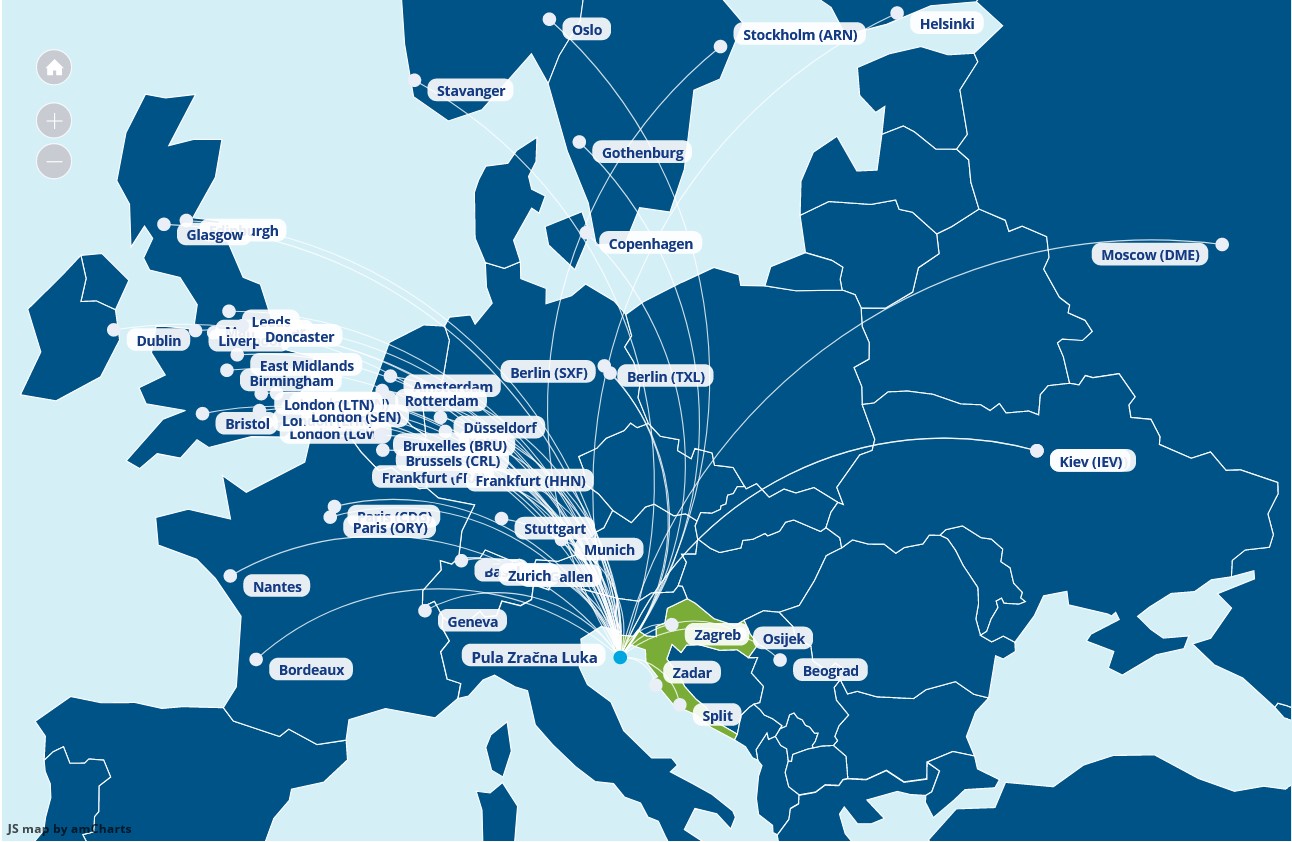
Screenshot Pula Airport
Follow TCN's dedicated page for the newest information about flights to Croatia.
How to get to Istria by bus?
If you come from neighboring countries, the bus may be a good option to get to Istria. Since northern and western Croatia is well-connected with northern Italy, you can get to Istria by bus from Trieste to Buje, Poreč, Rovinj, Pula, along with other places on the way. The bus from Trieste to the western part of Istria, as well as to Rijeka, operates throughout the year.
There are also bus lines from Venice to Pula by the Pula-based bus company FILS, operating the whole year. Another Pula-based bus company Brioni Pula provides bus services from Padova (with stops in Venice and Trieste) to Vodnjan, Rovinj, Buje, and Pula. All the bus lines from Italy to Croatia can be found here (in Croatian).
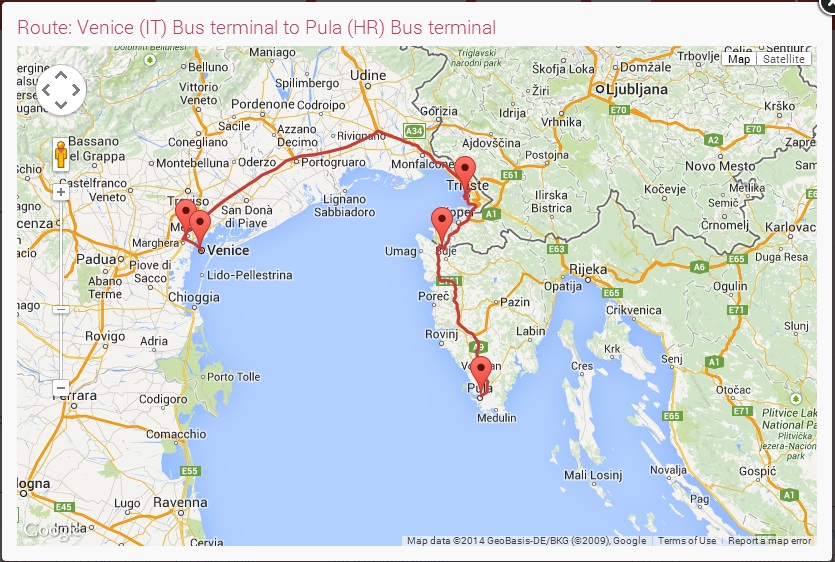
Bus routes from Venice, Italy to Pula, Croatia / Buscroatia.com
Istrian bus companies Brioni Pula i FILS also provide bus lines from many Croatian cities, mostly from the capital of Zagreb. If you're coming from continental Croatia, Istria is the closest seaside region to visit. There are many bus lines, especially during summer. You can find them also on the Flixbus and Arriva bus companies' webpages.
How to get to Istria by ferry?
Since Croatia has a sea border with Italy, one way to get to Istria from Italy is ferry. There are two ferry providers from Italy to Istria – Adriatic Lines and Venezia Lines.
Adriatic Lines operates from Venice to Istrian cities of Pula, Rovinj, Poreč, and Umag. Catamaran lines from port San Basilio in Venice to Istrian cities last about two and half hours. One-way ticket price is 65 euros (or 500 kunas) for adults and 32.50 euros (250 kunas) for children. The schedule for 2021 is still unavailable.
Adriatic Lines' catamarans are quite famous, as they are recognizable in Istrian ports. "Prince of Venice," mostly seen in Poreč port, has an attractive and distinctive design, while "Adriatic Jet" is known for its speed and interesting appearance.
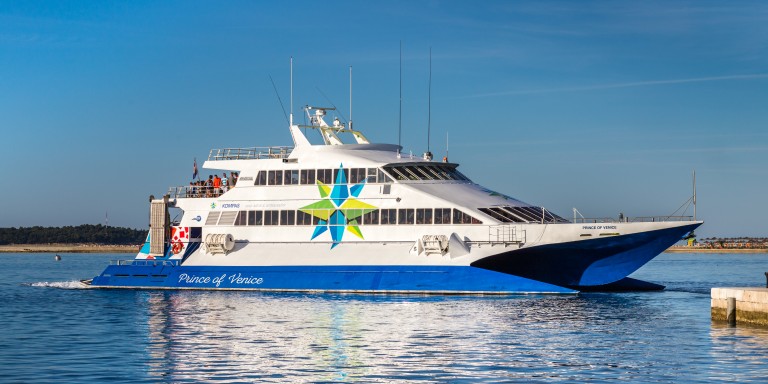
Prince of Venice in Poreč port / Adriatic Lines
During summer, namely from April to October, Venezia Lines have catamaran lines from Venice to Piran, Poreč, Pula, Rovinj, and Umag. Ticket prices range from 59 to 69 euros per person (450 to 520 kunas per person). It takes about three hours and 15-30 minutes to get in one direction, depending on the route. However, the schedule for 2021 has not yet been published.
Ferries from Istria to Italy also allow the transport of pets and bikes.
To find more ferries from Italy to Croatia, check the Istrian Sun webpage.
How to get to Istria by train?
If you decide to come to Istria by train, you can arrive very quickly using the lines from Ljubljana or Zagreb.
The line from Ljubljana can take you to Buzet or Pula every day and it takes four hours. There are no more trains going from Italy to Croatia.
If traveling from the Croatian capital, there are no direct train lines to Istria. However, you can take the train to Rijeka, but then travel by bus from Rijeka to Lupoglav, from where you can continue your train journey through Istria, to Pazin and Pula. The whole journey take four hours. You can book the train tickets on the Croatian Railways webpage.
Six railway stations in Istria are in Pula, Kanfanar (mentioned above as the center of Istrian Y), Vodnjan, Pazin, Buzet, and Lupoglav. Pula and Pazin are the main railway stations in Istria, from where you can quicky come to western Istrian cities of Poreč, Rovinj, and Novigrad.
Fun fact about travelling by train in Istria?
Did you know that Istria is home to the only island on the Adriatic coast connected by train? Its name is Uljanik and is one of the six islands in the Pula bay.
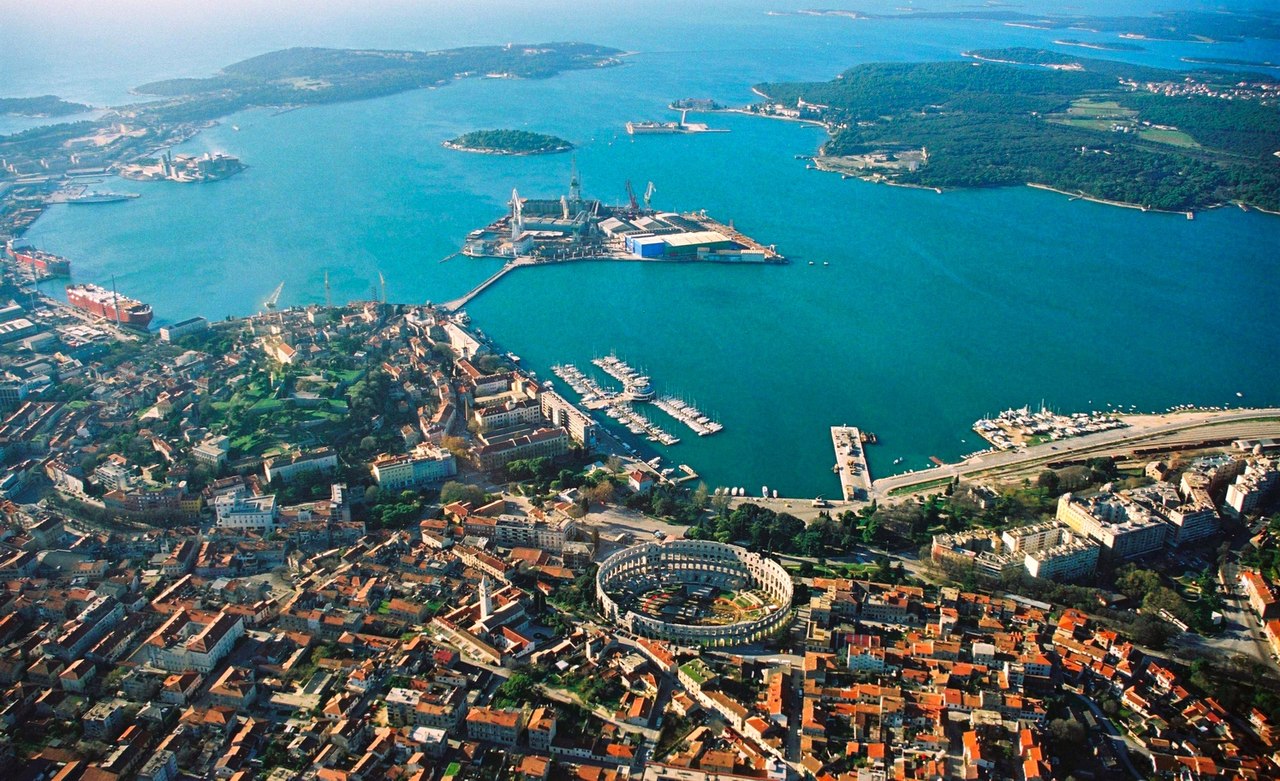
Pula and Uljanik island seen from above / Wikipedia
The name Uljanik, after which the nearby Pula shipyard was also named, comes from olive trees or, in Croatian, "ulike" that grew on it. Of all the olive trees, only one remained in the center of the island, surrounded by the Uljanik shipyard facilities, whose central plants are located on the island.
Interestingly, the industrial track for the shipyard Uljanik that goes from Pula railway station continues over the bridge, all over to the island of Uljanik. The bridge thus connects the island of Uljanik with the coast, making Uljanik the only Croatian island connected to the mainland by rail.
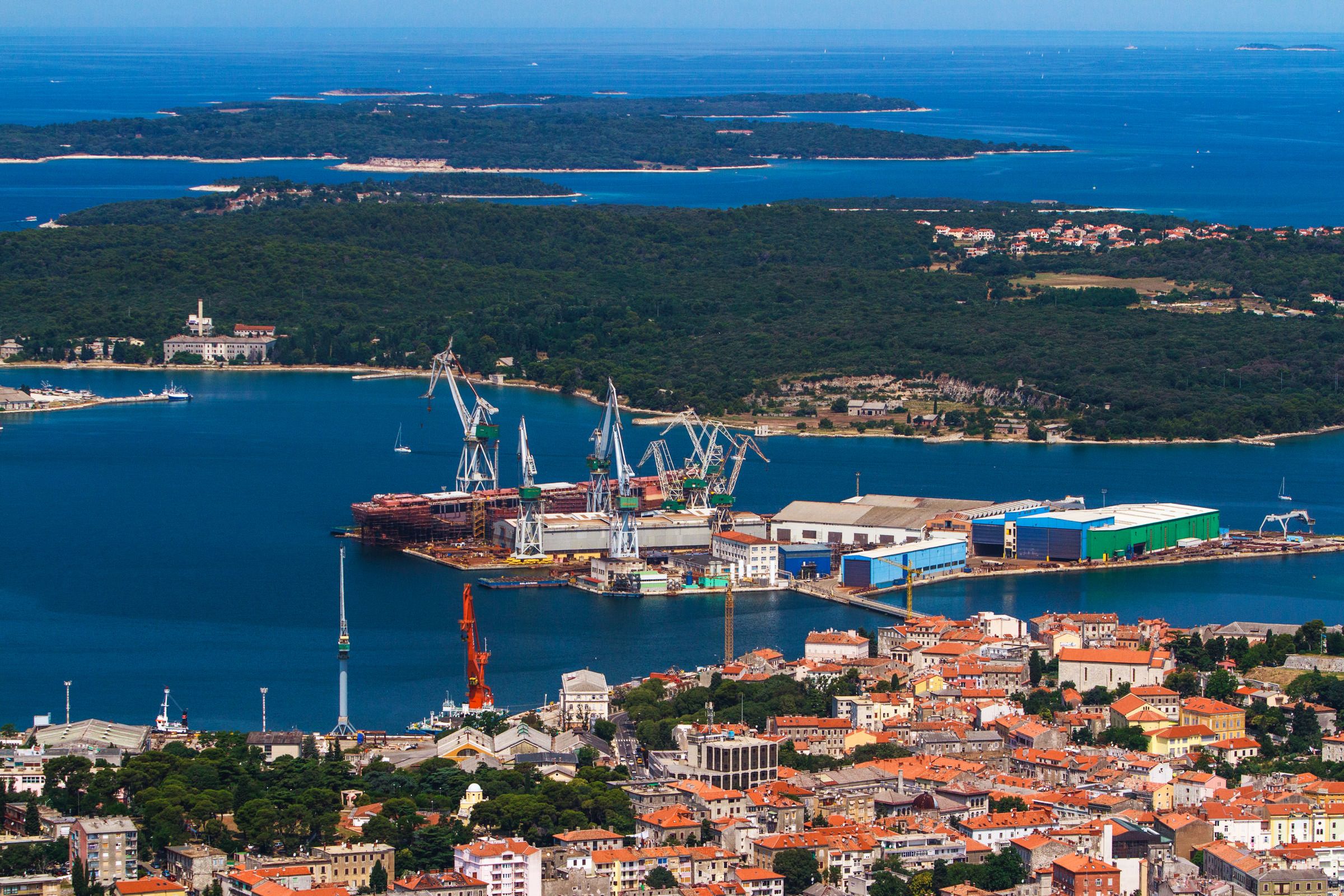
Uljanik shipyard's main plants on the island of Uljanik / Copyright Romulić and Stojčić
To follow the People Also Ask Google about Croatia series, click here.
Pazin First Town in Istria to Have Reclaimed Its Landfills
ZAGREB, July 28, 2020 - Pazin Mayor Renato Krulcic said on Tuesday that Pazin was the first town in Istria County to have rehabilitated and reclaimed its landfills.
Addressing a news conference, Krulcic said that local government had invested HRK 28 million of local budget money and EU funds in sustainable waste management in the last five years.
He went to say that a transfer station and a recycling yard have been built and a mobile recycling yard has been purchased for this town with a population of about 8,600.
Successful Donation Action for Animal Shelter in Pazin, Istria
Animal welfare is a burning issue for anyone who has half a heart, and in Croatia, there is a lot that could be improved at the city, county, municipal and even state level when it comes to respectable animal welfare practice. While some more popular tourist cities, such as Dubrovnik, continue to act ignorantly and fail absolutely miserably when it comes to animal welfare, other cities across Croatia are much more proactive. Pazin in Istria is one of them.
As Glas Istre/Andjelo Dagostin writes on the 4th of October, 2019, in the popular Poreč Italian Community building, a donation action for the Happy End Association - an asylum for both dogs and cats in Pazin, organised by the Poreč Lions Club, was held in Poreč's Freedom Square (Trg Slobode).
In the aforementioned building, a large number of members from Novigrad, Pula, Poreč and Opatija, as well as the residents of Poreč and a large number of children gathered together for the donation action.
It was an evening of magic, cabaret, poetry, dance, music with the participation of the magician Dario, cabaretist Davidina from Trieste (Italy), duo Anita and Dante Marušić from Buje, tenor Kristian Marušić from Grožnjan, poet Valter Turčinović from Buje, cellist Hana Gubić from Poreč, pianist Suzana Uršić, flamenco dancers of ASD Ventaglio from Trieste (choreographed by Hana Rivano), "Wild Country Dancers" from the Buje-based ''Liv'' Association, Ele Dance from Trieste, Mrs. Bojana and her dog Frida's show, and the presentation of the dog hotel ''Istra Dog Land''.
All the performers performed for free in order to collect animal food, medicine and donation money for the Pazin-based Happy End Association, which cares for a large number of dogs and cats in its asylum. Everybody in attendance donated money or brought food for the dogs and cats instead of tickets, and a light dinner and drinks was organised for everyone after the show.
A special contribution was made by the Bau Miao Help Association from Buje, which collected and brought in 29.5 kilograms of dog biscuits, 14 kilograms of cat biscuits, 21 kilograms of wet food (meat) for cats, 21 kilograms of cat meat, five kilograms of cat litter with anti-odor granules included, large and small containers, pillows and blankets.
In total, more than ten thousand kuna was donated in cash for the purchase of yet more food and animal medicines, and around the same amount was donated in both dog and cat food.
Make sure to follow our dedicated lifestyle page for much more.
Foreign Chefs Attend Autumn Culinary Workshops in Istria
As Glas Istre/Andjelo Dagostin writes on the 30th of September, 2019, the tourists Istria wants to attract typically want to eat locally, authentically, they want the experience and not just the food, because they can get international food everywhere in the world.
Although the Educational Gastronomic Centre of Istria, located near Pazin, has so far been less widely known, the fact remains that their numerous cooking workshops (115 of them) have been attended by more than 1,200 students over the past four years, mainly by local chefs from Istria, as well as hospitality workers and hoteliers.
Glas Istre sat down and talked to Edmond Šuran, head of the Centre for Rural Entrepreneurship Development, who had a lot to say.
Everything starts from the point of agriculture and the task of our agency was to put a spring back in the step of Istria's agriculture workers. We used this to use gastronomy as a superior tool for the additional valorisation of local products, because from the experience we had with Istrian cattle, the biggest shift happened when the meat ended up in the hands of the chef.
At the first moment, it was mostly agritourism and taverns, and very soon after, restaurants and hotels with 4 or 5 stars, and now these are already Michelin-starred restaurants that want to have Boškarin (type of cattle) on offer, which is great.
All of this was created at AZRRI, and through gastronomy it was then placed on the market. That was a trend at the time, but today, that's almost a type of gastronomic brand, says Šuran, adding that 80 to 90 hospitality establishments currently offer Istrian beef, and restaurants in Primorje, Zagreb, Slovenia and even across the Adriatic in Italy also offer it. They want to achieve the same with the meat of the Istrian donkey, which is currently being offered in a dozen restaurants across Istria.
''At the moment, the demand for Istrian donkey meat is growing, and quite quickly, even those who raise it aren't managing to meet the needs of the market,'' continued Šuran, adding that the goal is to achieve such an impressive level of valorisation with other Istrian products, including media promotion.
At AZRRI, they listen to the needs of Istria's chefs and others, but also the mentor-lecturers who are constantly interacting with the chefs. Due to the relative limitations of the top culinary staff in the peninsula, AZRRI has not limited itself solely to Istria, so they invite excellent chefs with new ideas from all over Croatia and even from abroad. The cooking workshops are attended by established chefs with experience who are looking for inspiration, but also younger chefs with whom much work is being done to accelerate culinary techniques.
''We must not forget that in the best restaurants, the dish is presented not only by the waiter, but very often by the chef, precisely because he's familiar with the primary food, whether it's boar meat, blue fish or mozzarella, so the chef gives that dish its contents, its value, and he can tell the guest the story of the meal and he appreciates what goes into it,'' explained Šuran, adding that not all those on Istria's hospitality scene are expected to position themselves in high gastronomy, but those who do want that will have to interact with the guest.
''We're especially pleased that many young chefs and caterers are implementing the knowledge they've acquired here, using new details and culinary tricks. We see this when we go around the field,'' said Šuran, adding that after four years, it's difficult to maintain the level of innovation in the cooking workshops, but he believes that they still succeed in inviting new chefs every year. So, they are still attracting students who mostly come from Istria, then from many other parts of Croatia, but also from Italy, Slovenia and from down south in Montenegro.
''These chefs also come back to attend new workshops every year, The majority of attendees come from the private hospitality sector, but over the last two years, hoteliers from Istria have also become active, often booking the entire workshop for their employees.
I know that it may be a little harder for hotel companies to implement the knowledge they acquire here, because they have certain business templates and integrated public procurement, but it's commendable that these chefs still do come and acquire new knowledge, experience, and skills here that can then influence managers to adopt at least a bit of it. And that does happen!'' he noted.
He cited the fact that the largest amount of Istrian cattle meat was consumed in one restaurant within a hotel house in Istria, as an example of influence. However, when the head chef left that restaurant, larger quantities of meat were no longer ordered there, but they were then made available in restaurant where that chef had moved.
Make sure to follow our dedicated lifestyle page for much more.
World's Biggest Welcome in Croatia: Day 4 - Pazin to Labin (Kayak, Bike)
March 31, 2019 - Putting Croatian adventure tourism on the map, with the biggest welcome in the world. Day 4 of this incredible 2011 adrenaline trip covering 2,500 km along the Croatian coast.
The World's Biggest Welcome, an ambitious adventure tourism project in 2011 in Croatia enters Day 4 of this 2019 appreciation of one of the finest tourism promotion projects ever in Croatia.
The plan? To showcase the diversity and fabulous offer of adventure tourism in Croatia by following a GPS route the length of the Croatian coast in the shape of the word 'Welcome' - thereby creating the biggest welcome in the world from a hospitable tourism country.
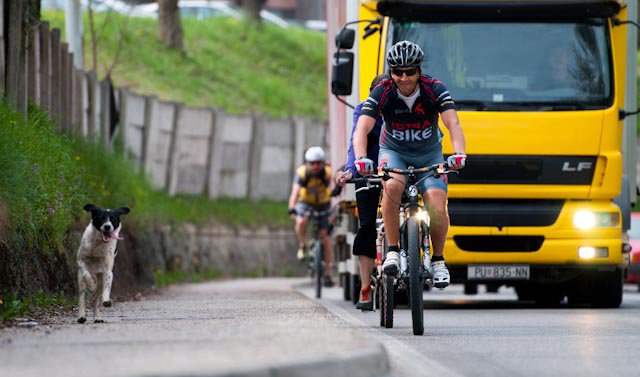
Day 4 was a 3-stage kayak and bike ride from Pazin to Labin, and there was even four-legged support on the initial cycle from Pazin.
65 kilometres for the day: 20 km by bike from Pazin to Rasa, followed by a 20 km kayak paddle from Rasa to Koromacno, before heading north once more on the final part of the first letter (W of Welcome), 25 km to the overnight resting point of Labin.

Lacko managed to outpace some of the locals ascending the glorious hills of Istria.
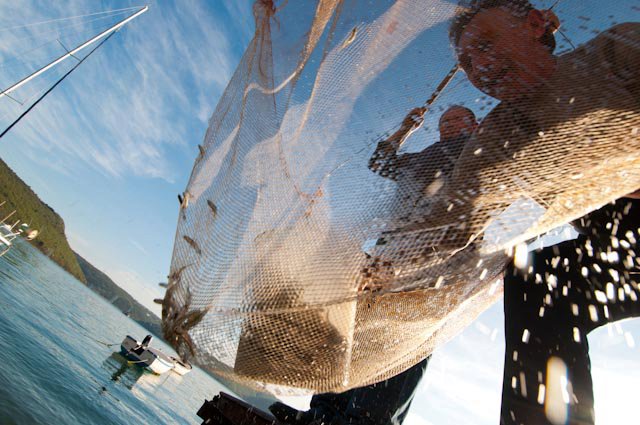
It was also an opportunity to observe and appreciate the traditional way of life of the locals in Istria. Here, the locals are fishing for whitebait in Trget.
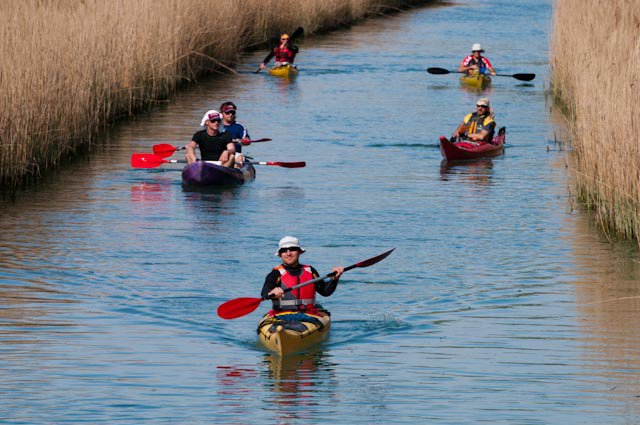
The early stages of the World's Biggest Welcome were dominated by sea kayaking, and Lacko was back in the water for the second leg of the day. negotiating the River Rasa channel with companions.
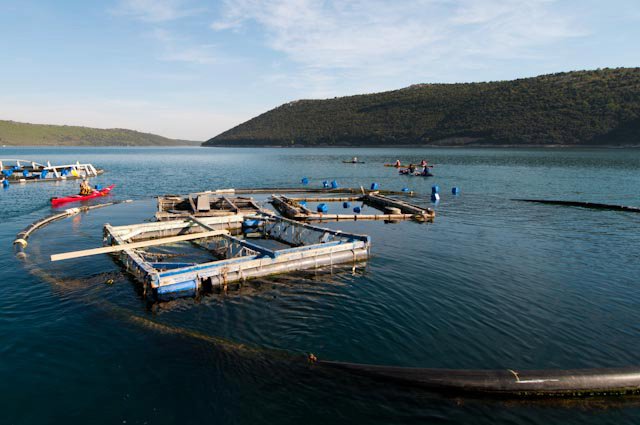
There was plenty to see along the way, including the mussel farms of Rasa.
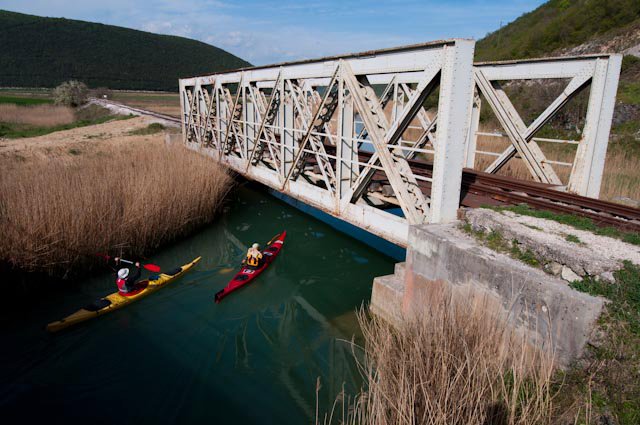
Onwards under a bridge on River Rasa.
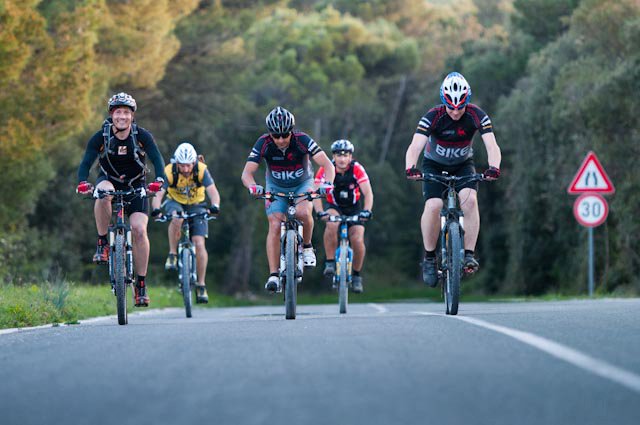
Istria is fast becoming one of the most exciting cycling destinations in the region, with its rolling green hills, exceptional vineyards and historic stone hilltop towns. The last leg of the day was a cycle along the eastern part of the peninsula.
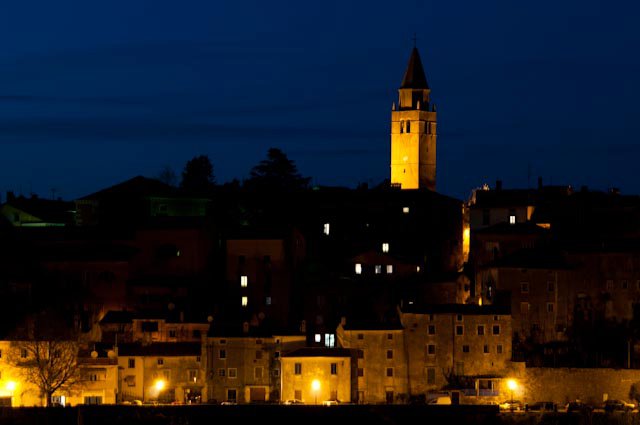
Destination Labin, yet one more touristic jewel on the region they call 'the Croatian Tuscany'.
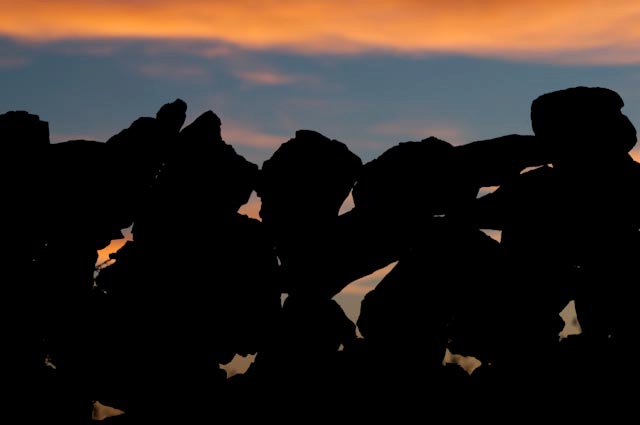
And no day would be complete without photographer Luka Tambaca capturing another glorious sunset, this time through Croatia's famous dry stone walls.
A key part of the project was promoting tourism, and the official website has details of the key places visited during the day. Pazin.
You can see the entire project on the Welcome website, as well as much more of Luka Tambaca's stunning photography on the Welcome Facebook page.
Tune in tomorrow for Day 5, as Lacko moves from Labin to Opatija by bike and on foot.
To follow the whole project from the start, follow the dedicated TCN page.
World's Biggest Welcome in Croatia: Day 3 - Brijuni to Pazin (Kayak, Bike, Speleo)
March 30, 2019 - Putting Croatian adventure tourism on the map, with the biggest welcome in the world. Day 3 of this incredible 2011 adrenaline trip covering 2,500 km along the Croatian coast.
The World's Biggest Welcome, an ambitious adventure tourism project in 2011 in Croatia enters Day 3 of this 2019 appreciation of one of the finest tourism promotion projects ever in Croatia.
The plan? To showcase the diversity and fabulous offer of adventure tourism in Croatia by following a GPS route the length of the Croatian coast in the shape of the word 'Welcome' - thereby creating the biggest welcome in the world from a hospitable tourism country.
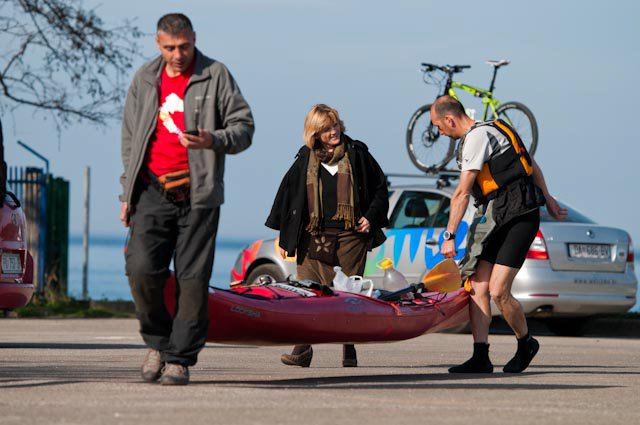
Having started on the Slovenian border in Savudrija, Daniel Lacko spent the first two days kayaking 80 km along the Istrian coastline to Brijuni. Another early start on Day 3.
In order to work on forming the first letter 'W', Lacko headed north and inland, combining his kayaking with cycling and speleo-alpinism.
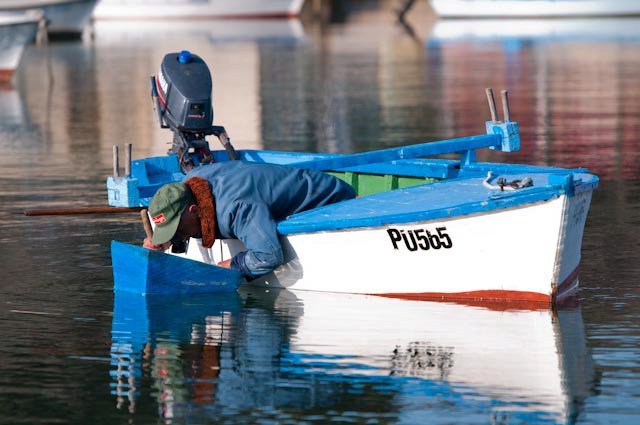
He was not the only man up early that morning. The timeless Adriatic.
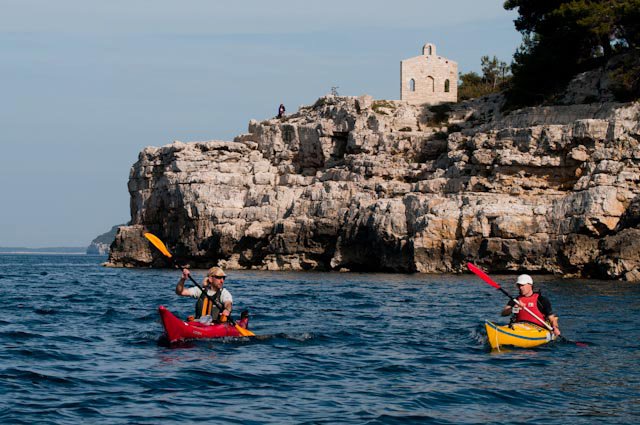
The first part of a busy day was a 25 km kayak paddle from Brijuni to Pula, passing Verudela.
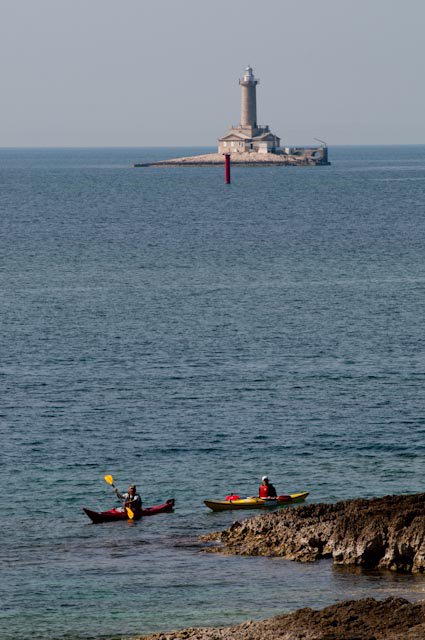
Time to head north at the southernmost part of the Istrian Peninsula, Cape Kamenjak.
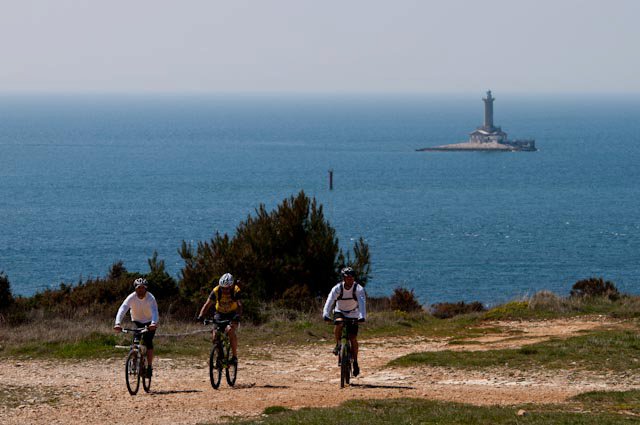
After more than 100 km of sea kayaking, the journey hit dry land for the first time, with the kayak exchanged for a bicycle. Destination Pazin, some 60 km away.
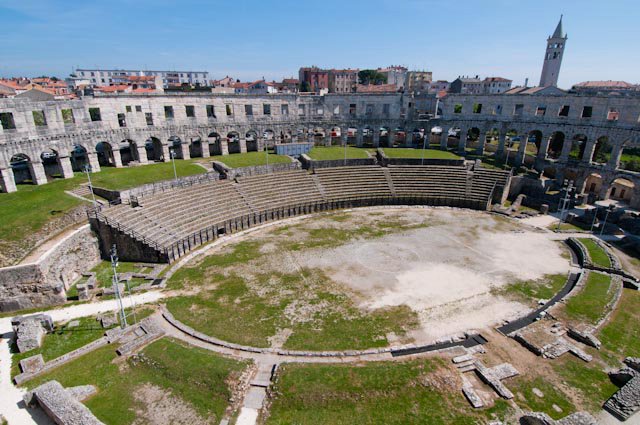
One of the most impressive and important tourist attractions in all Croatia had to be visited along the way. The outstanding Pula Area, the sixth largest Roman amphitheatre in the world.
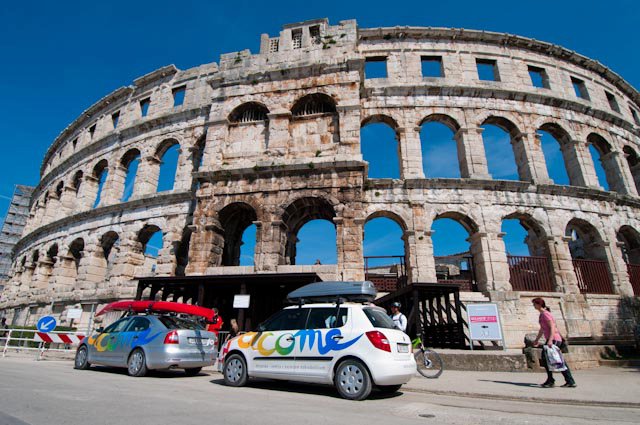
Did you know that this ancient treasure has been used for some of the most innovative modern-day tourism projects, including an ice-hockey match, gladiator fights and concert venue for the likes of Sting and Leonard Cohen?
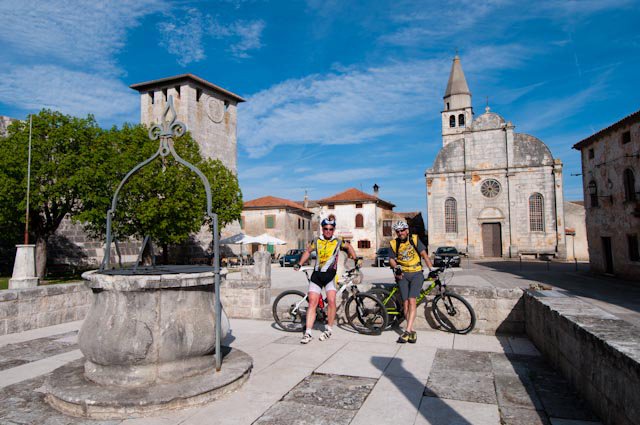
Cycling the green hills of Istria with its idyllic historic mountain villages is an increasingly popular attraction, and no wonder with beauty like this. A quick stop at St. Vincent.
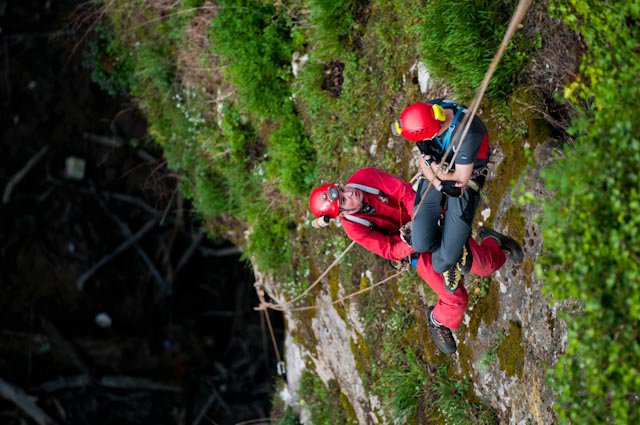
Final stop Pazin, but there was no time to rest just yet. One more kilometre to go, with a little speleo-alpinism at Pazin Pit, quite a change from paddling the calm waters of the Adriatic.
A key part of the project was promoting tourism, and the official website has details of the key places visited during the day. Brijuni.
Pula and Pazin.
You can see the entire project on the Welcome website, as well as much more of Luka Tambaca's stunning photography on the Welcome Facebook page.
Tune in tomorrow for Day 4, as Lacko moves from Pazin to Labin by bike and kayak.
To follow the whole project from the start, follow the dedicated TCN page.


